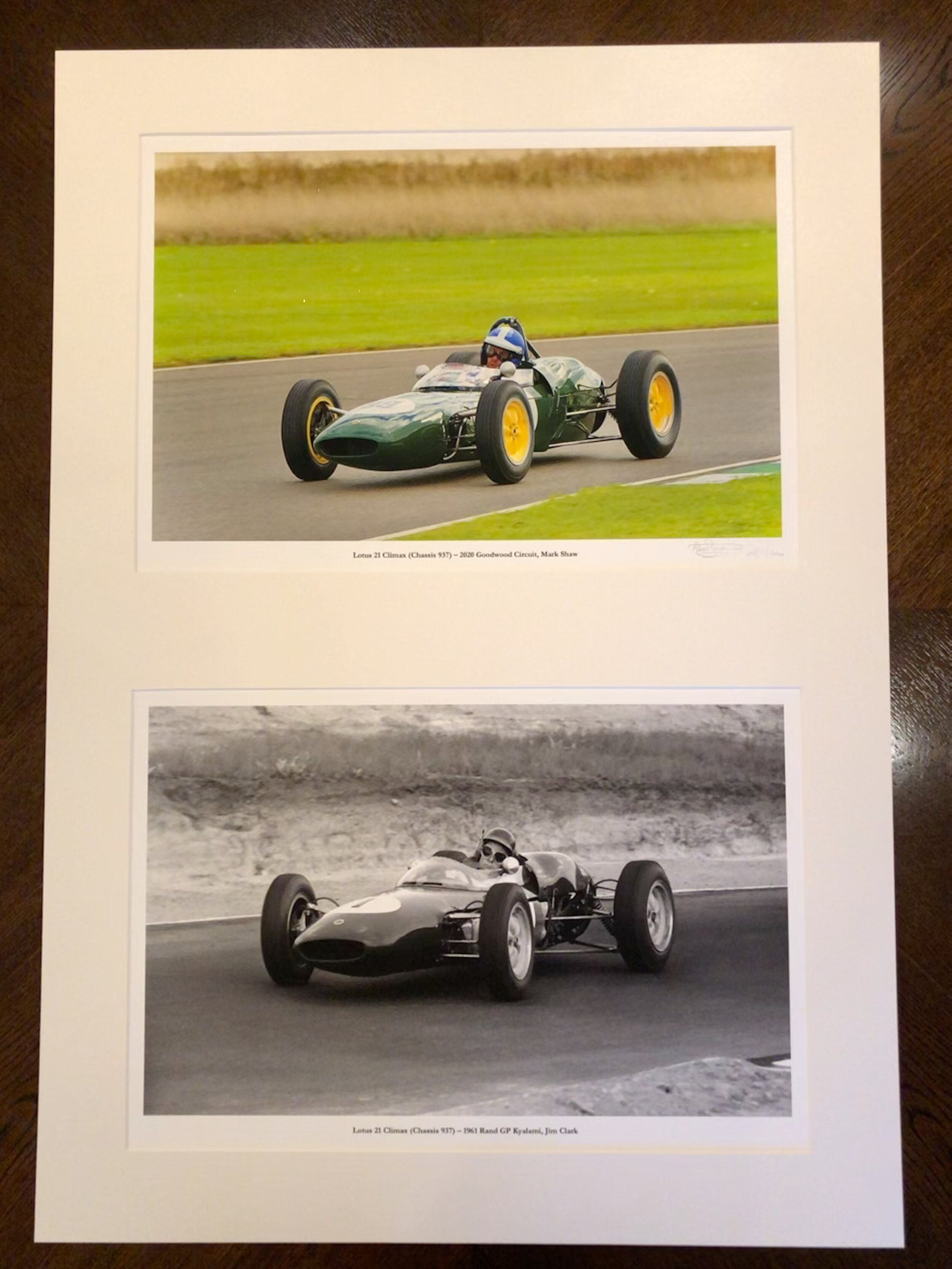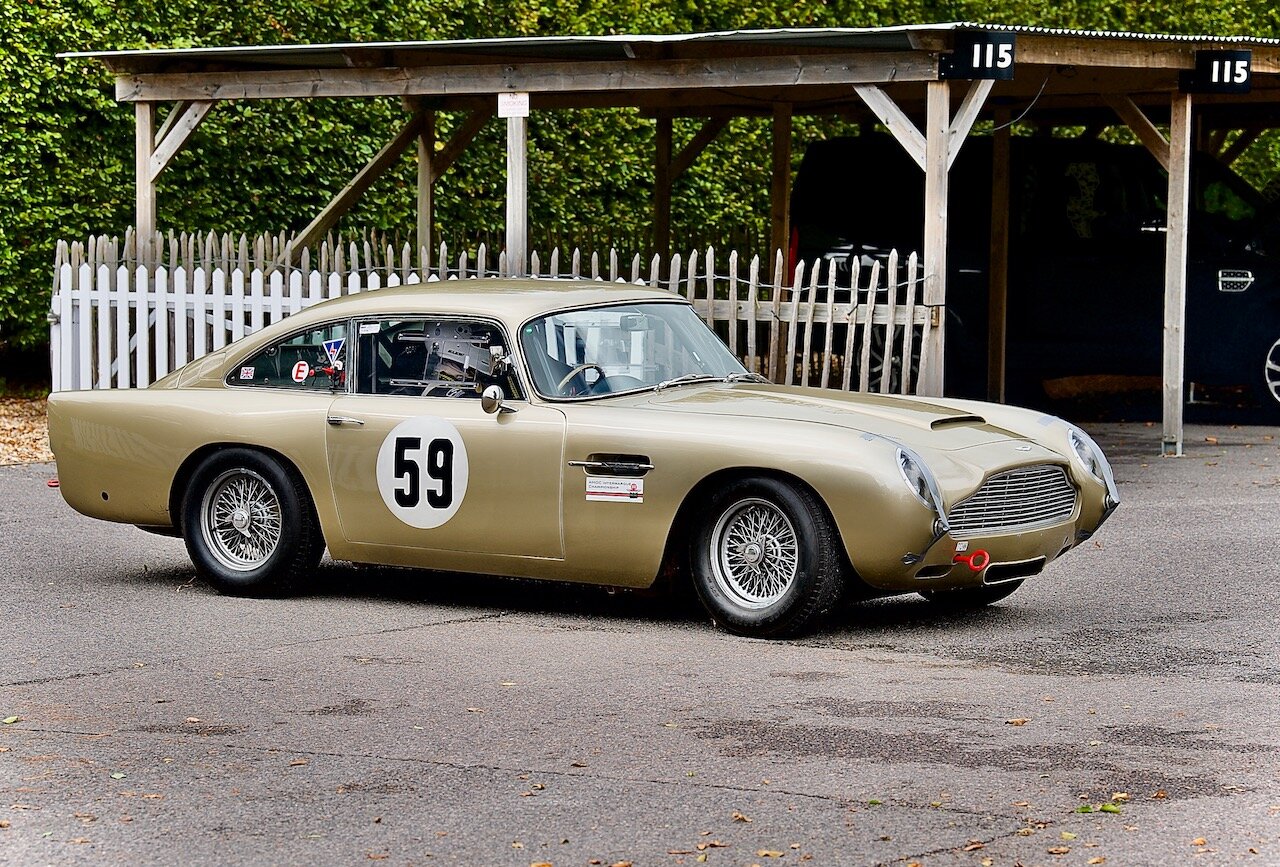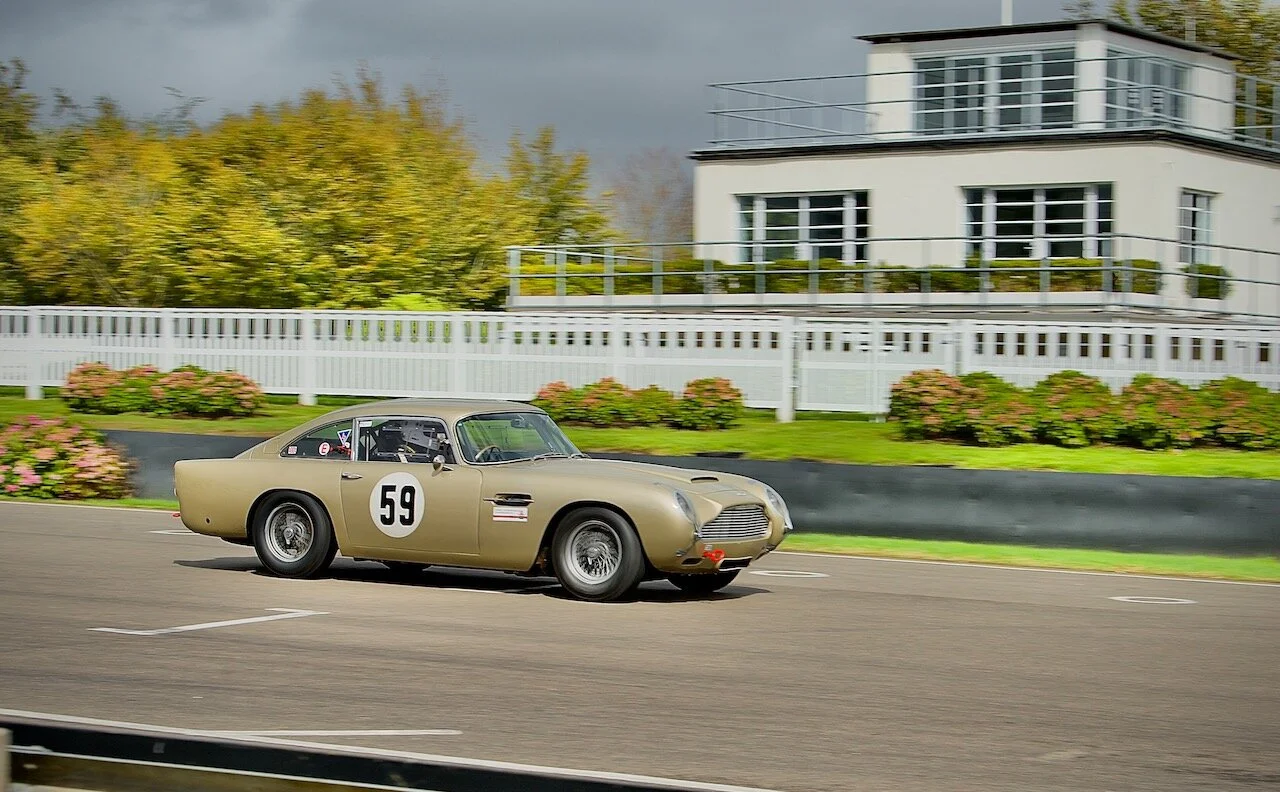1961 Lotus 21 Climax (Chassis no 937) - This is a recent commission I had from the current owner of this car. It combines my photo of him driving the car at the Goodwood Motor Circuit with a B&W image of Jim Clark driving the car in the 1961 Rand GP at Kyalami in South Africa. It was great to have two images that complement each other so well (despite the very different locations!) and they help put the car in its historical context. The work also involved cleaning up the B&W image suitable for large size printing, the whole picture being in an A1 size mount.
"The Hairy Canary"
1963 AC Shelby Cobra 289 (Chassis no CSX2151) - The “Hairy Canary” is well known and instantly recognisable for its distinctive livery, but fewer people probably have heard its history. The car has been a competition car all its life and not used as a road car and is one of the few Independent Competition Cobras as verified by the Shelby American Automobile Club (SAAC). Although it has been restored, due to the limited number of owners it has had and its restriction to racing, it is highly original, carrying many of the car’s original parts including body panels. The car’s first owner was a young American Dick Neil Jr, who had previously owned a Mk1 Cobra, which he started to drive across the US from the East to the West Coast on his way to living in Hawaii. Due to to recurring problems with the Mk1 car, Neil had to abandon his long drive and instead shipped the car to Shelby’s California workshop for repair. In managing Neil’s dissatisfaction, Shelby persuaded him to part exchange the Mk1 for a “brand new 1964 model” - the car was actually fully specced for competition use and not a road car, so it used the new rack and pinion steering, 289 cu inch/4.7 litre engine with extra side vents and racier rear-drive ratios, one of the first Cobras with this set up. It was actually painted in Vineland Green with a beige interior, as well as having American Racing five-spoke wheels, Weber carburettors, competition scattershield and a roll bar. Neil shipped the car to Hawaii and entered his first novice race in October 1963, a support race for the Hawaiian Grand Prix in which famous Cobra drivers Ken Miles and Dave McDonald were competing. Neil was not successful in that first race, but it cemented his enthusiasm to compete and he started a full race programme culminating in a 3rd place in class (5th overall) at the 1964 Hawaiian Grand Prix and a 1st in class (2nd overall) in the following year. He also set a long-standing lap record for the Hawaii Raceway Park. It was early in this period that he picked up sponsorship from DynaGlaze and in 1964 had the car painted in its now famous yellow livery, after a small accident. The colour perhaps echoes that of privateer Allen Grant’s Coventry Motors car, which was a strong challenger to the works run Cobras of the period. Reputedly Grant’s car livery was originally penned by his friend, George Lucas of later "Star Wars" fame. It was during that period in Hawaii that the car first picked up the nickname of the “Hairy Canary”. In 1965 Neil moved to British Columbia and continued to race the car in the North West through to 1972 when he eventually sold it. The car had another 10 years of racing under two owners and also ended up being painted white, before it was retired and effectively put in to storage for some 20 years before being sold to Bill Bridges, an established British Cobra racer. He shipped the car to the UK and faithfully restored it to the specification it had in its heyday in Hawaii. One of its first outings after restoration was at the Goodwood Revival in the RAC TT Celebration Trophy where, despite a snapped accelerator pedal when being driven by Desiré Wilson in qualifying, the car went on to finish in the top 10. It has raced at the Revival some dozen times in total as well as appearing at numerous historic events Worldwide and has been driven by many other established racing drivers including David Franklin, Brian Redman and Stuart Graham. It has recently changed ownership again but continues to race. Pictures here are at the Goodwood Motor Circuit.
Car design as art - 1938 Bugatti Type 57 Atalante Coupé by Gangloff
1938 Bugatti Type 57 Atalante Coupé by Gangloff (chassis no 57633) - In the Type 57 you have an example of where car design transcends into art to create a true masterpiece. The Type 57 is the best known and most desirable of Bugatti vintage cars and was in production between 1934 and 1940. Conceived solely as a road car, though a version designated the 57G was designed for racing in the 1937 24 Heures du Mans and a Supercharged version raced in 1939. Both cars were victorious giving Bugatti their only two Le Mans winners. The Type 57 could be ordered with bespoke bodies, but the most popular coachwork for the Atalante was Jean Bugatti's in-house version executed by coachbuilder, Gangloff of Colmar, just a few miles from the Bugatti Molsheim works. The name Atalante derives from Greek mythology, being a swift-footed huntress who would only marry a man that could outrun her. The cars are powered by a 3.3 litre DOHC straight-eight engine, giving a power output of some 140bhp, notably in excess of the typical 115bhp of contemporary Bentleys of the day. As a result it attracted buyers seeking elegance and speed, among them the famous speed record holder Sir Malcolm Campbell. Chassis '57633' is one of the later versions, therefore benefitting from later technical evolutions in the design. Whilst it was bodied by Gangloff with the “standard” body version, the original buyer of the car Fernand Crouzet specified it with some special features in the extended rear bodywork, boot-lid mounted spare wheel, special bumpers and wheel discs, making it unique. The original colour of the car was two-tone black over blue. The car was hidden away during WW2 to avoid it being taken and survived to go into service as one of the French Embassy's official cars in London after the war. In 1948 the car was sold to a private owner in Scotland and passed through a couple more owners being used regularly before being ‘found’ in poor condition in 1987 in a shed, the last owner having died ten years previously. The car was bought at auction and taken to the US by collector Peter Ministrelli where it was completely renovated to original condition and specification, except for the colour. The quality of the restoration allowed the car to become a prominent and successful entrant at a number of prestigious concours, before it was sold and returned to the UK around 2007, since which it has remained there. All of the Atalante cars are highly desirable and rarely come up for sale, consequently when they do, they sell for considerable million dollar sums. A supercar of its time, whose artistic design and elegance is not matched by the supercars of today.
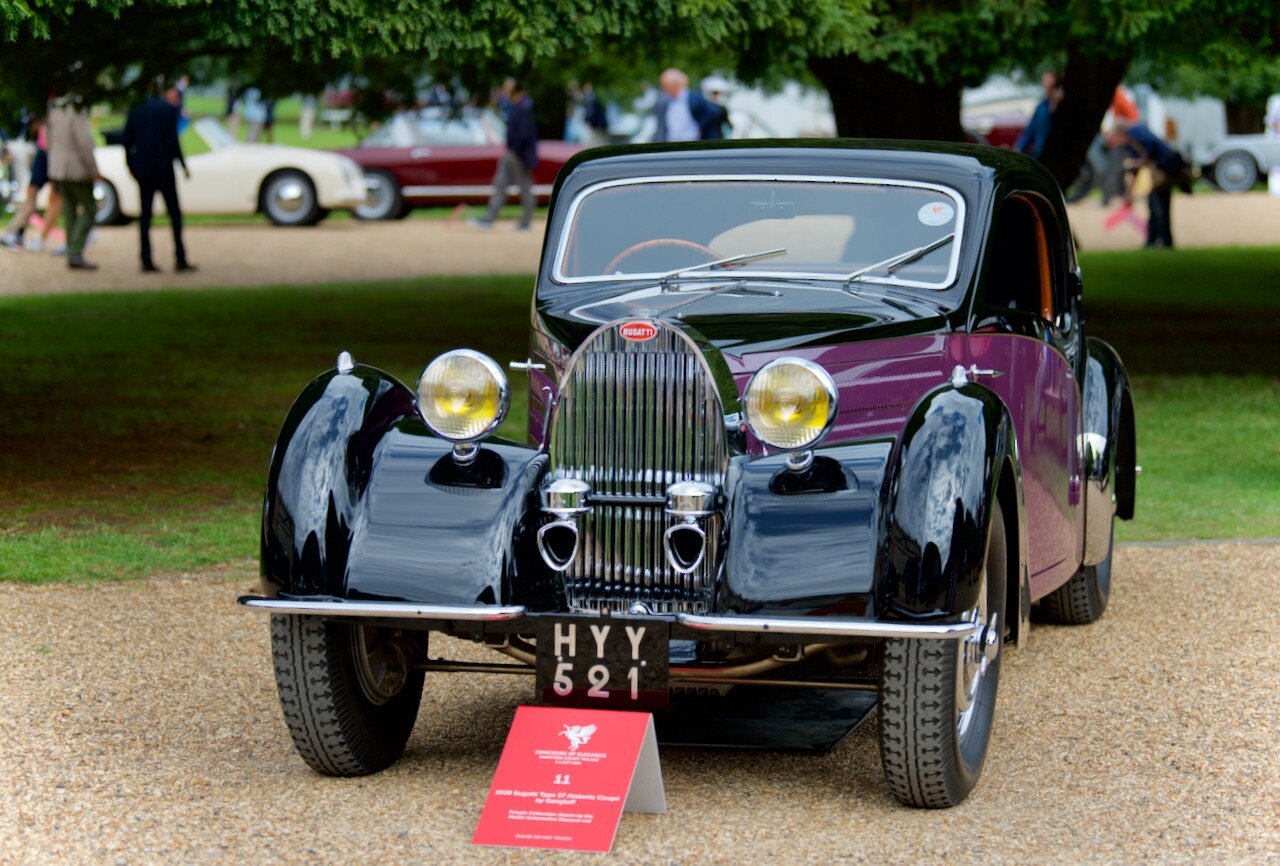
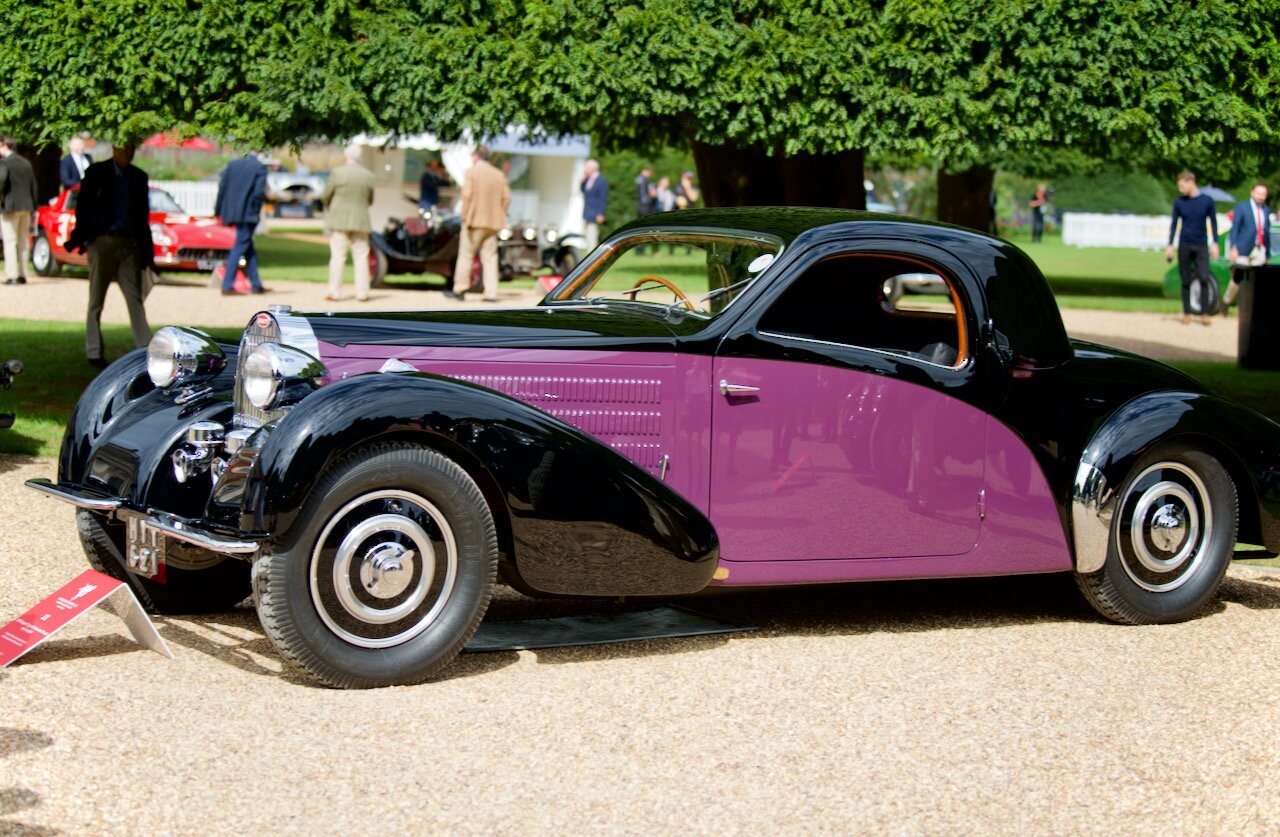

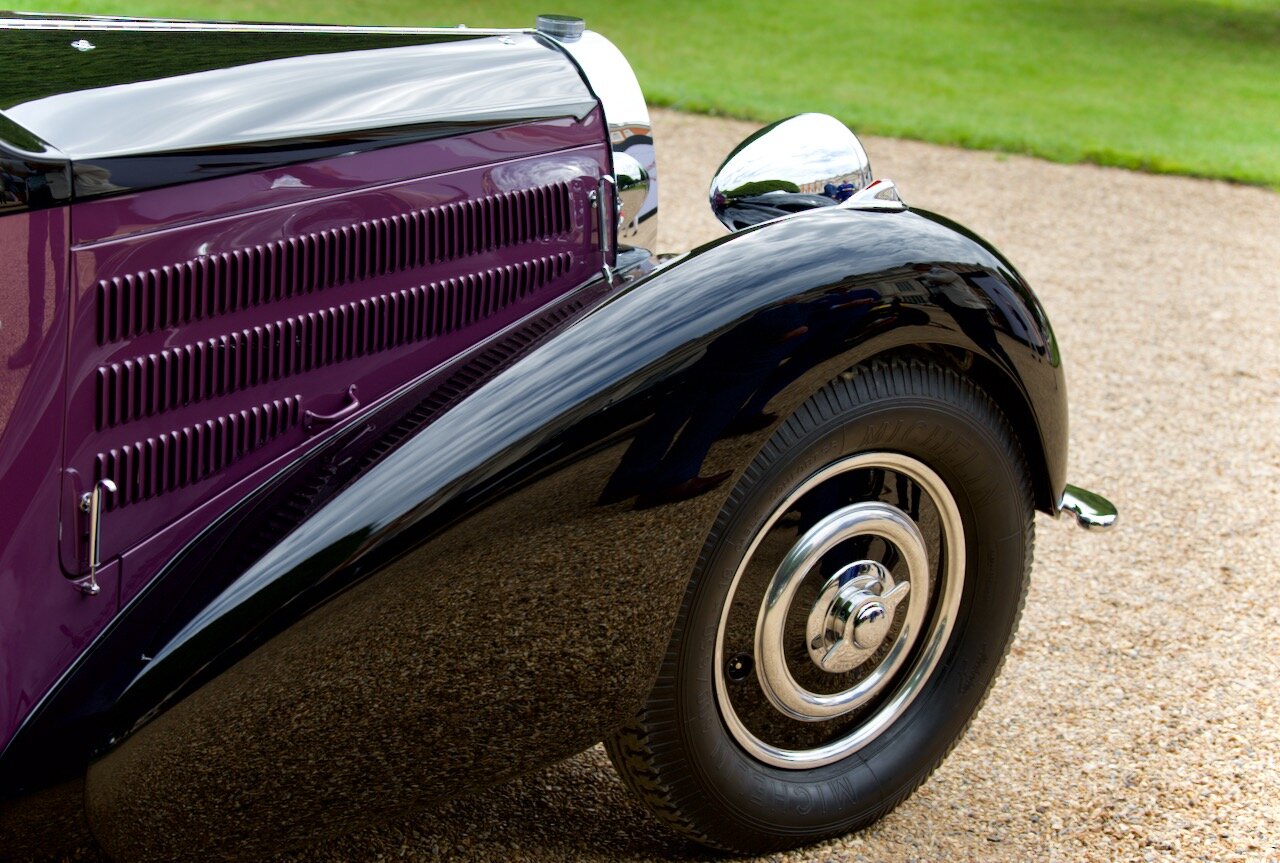
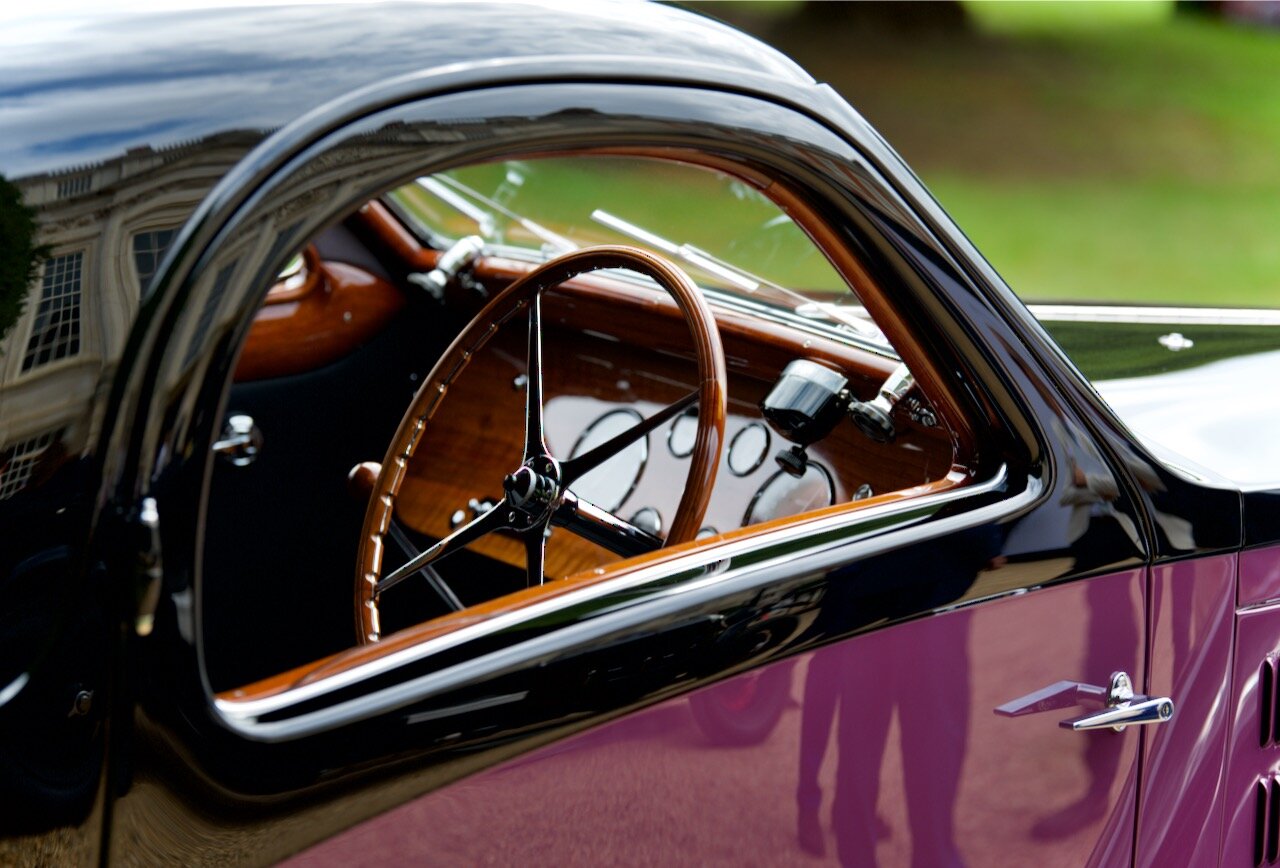

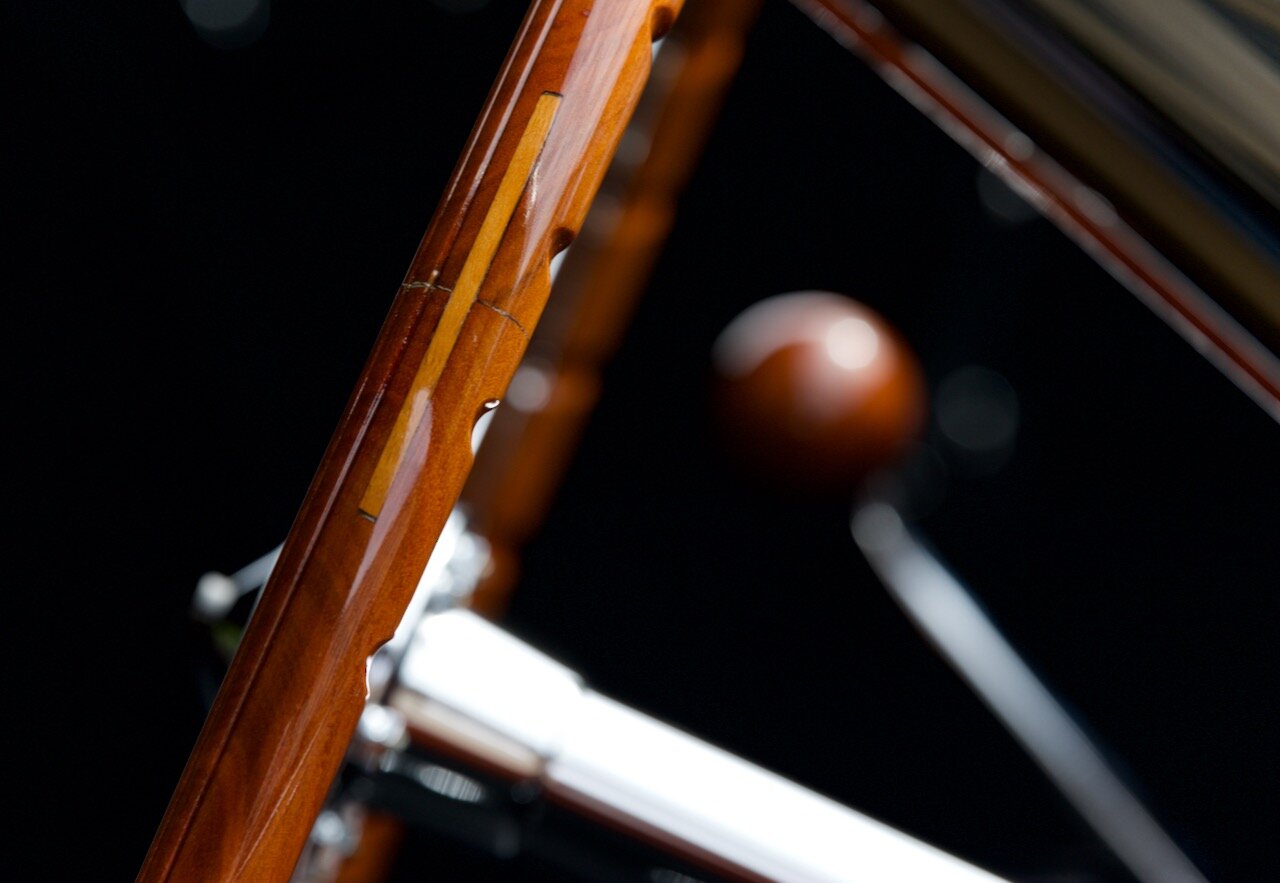

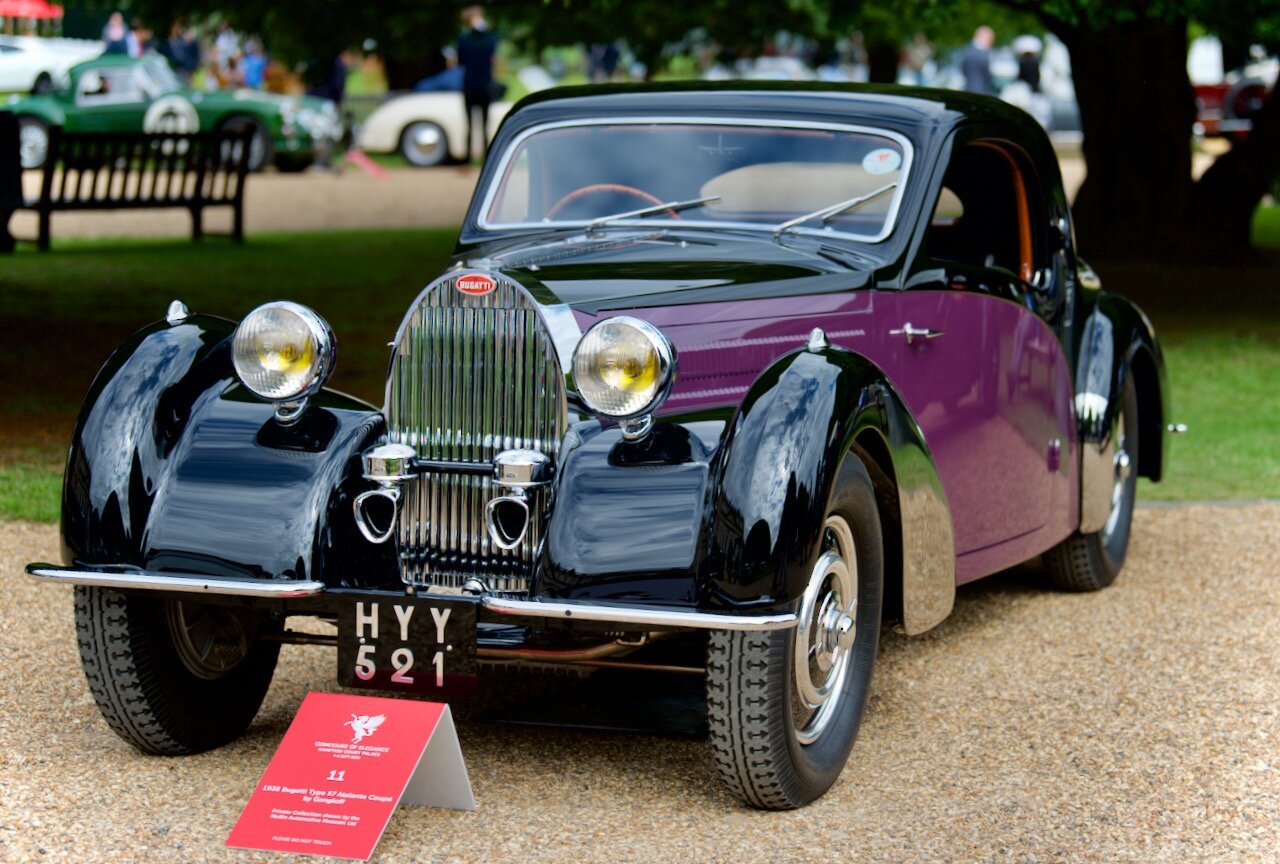
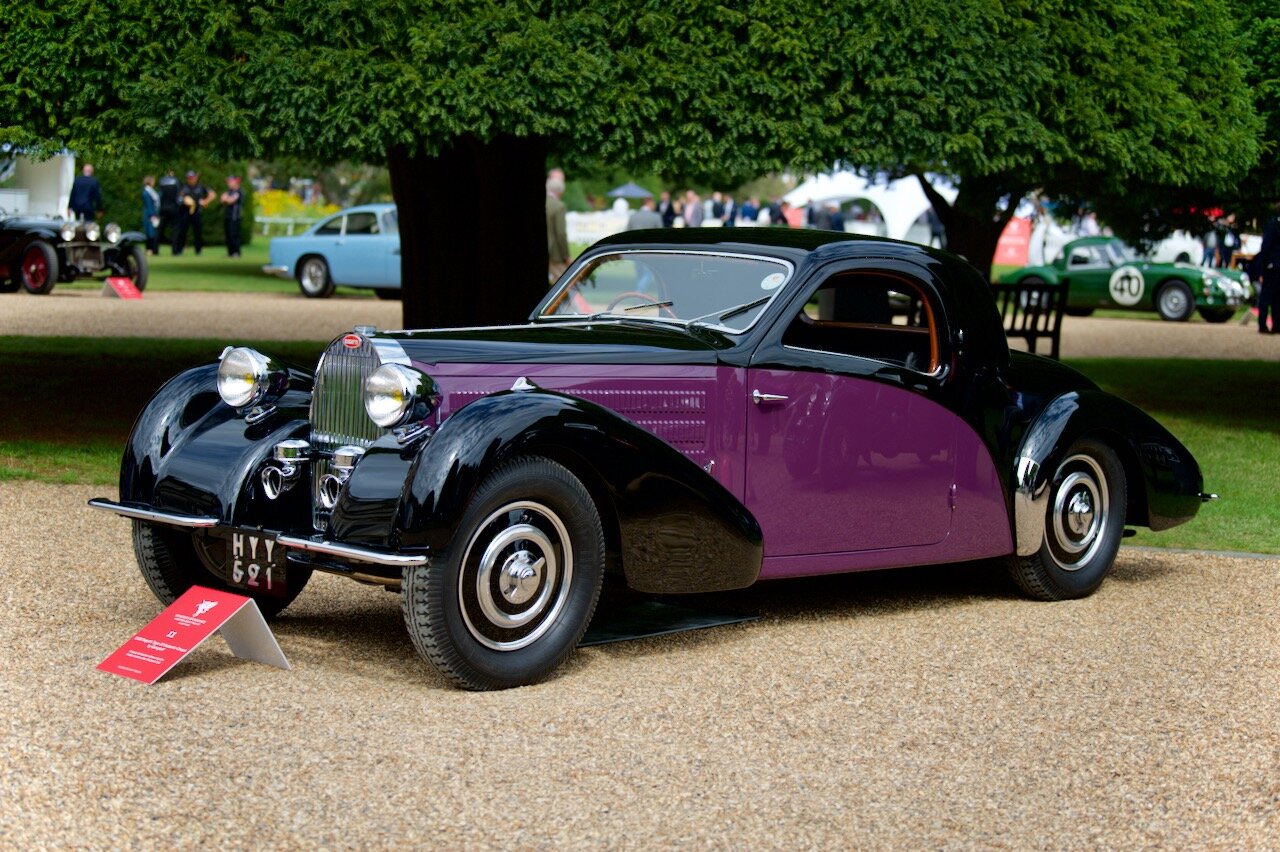


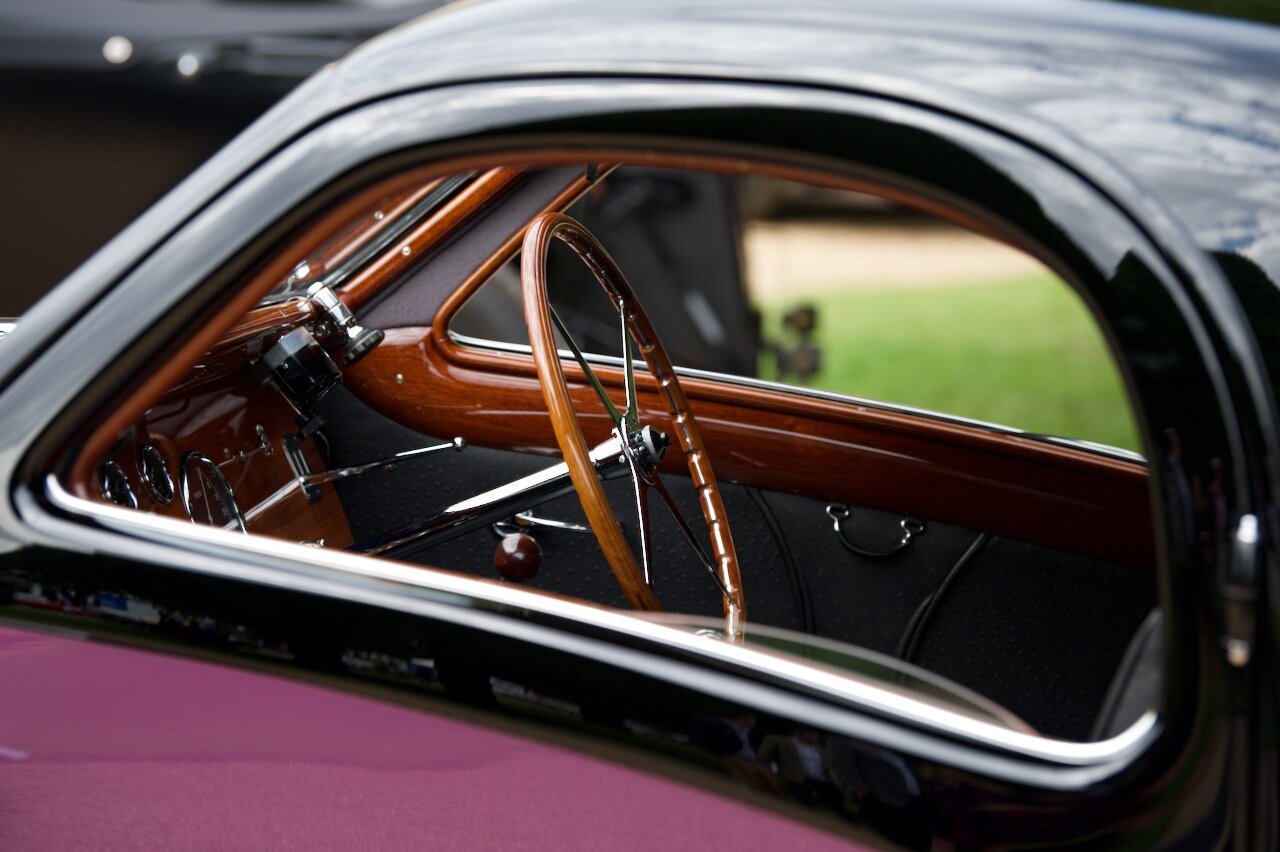
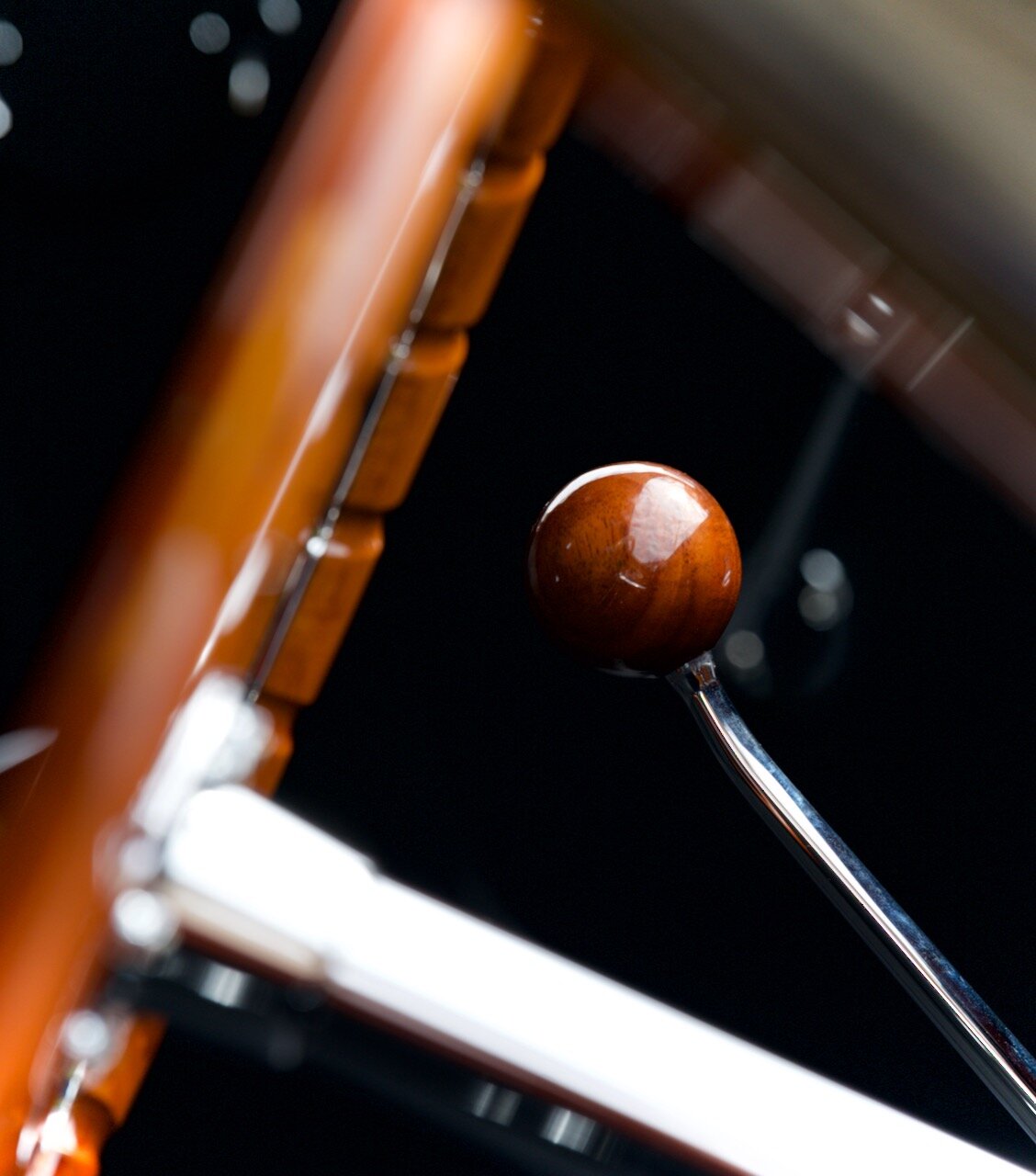
Jaguar XK150 S Coupé by Bertone drives around the fountain at Hampton Court Concours of Elegance 2020
British engineering meets Italian style - 1957 Jaguar XK150 S by Bertone
1957 Jaguar XK150 S Bertone (Chassis number: S834365) - This is one of three XK150s styled with custom coachwork by the Bertone design studio. This is believed to be the only one of the three cars that has survived, though they were all slightly different in any case. Franco Scaglione was the specific designer who worked on the cars and some of his more famous creations include the Lamborghini 350GTV prototype, the Alfa Romeo B.A.T cars and the Alfa Romeo Tipo 33 Stradale. All three Bertone XK150s were Fixed Head Coupés and the differences between them were in areas like window shaping, rear-lights and wheel-arches. From old photos this is the only one of the three that seems to have been given the finned side vents, though it is not inconceivable that they were added later in the car’s life, as they were often a feature of slightly later cars from the late 1960s. There is some thought that the cars were commissioned as design studies for a possible XK150 replacement, which eventually was the E-type. The cars did carry an “XKE” badge on their rear wing - a lovely crafted touch as can be seen on this car. However, none of the style obviously carried through to the E-type and from other accounts it seems more likely that the cars were commissioned as part of continued “brand enhancement” and in response to specific customer requests for special cars. John Coombs recounts a story of being involved in the commissioning of a gold-flecked red car, which was probably the only right hand drive version and the last of the three made. The car pictured here is the second of the cars and was originally shipped as a chassis to Italy in August 1957. It was possibly painted a shade of brown when it was first manufactured though it was reportedly also green for many years whilst it resided in Italy and then later photos show it sporting a red livery. The car has been restored at various points in its life, including more lately by the current owner Daniel Donovan. This latest renovation has resulted in the current Jet Black paint scheme with a Saddle Tan interior. The car is powered by Jaguar’s iconic 3.8 litre DOHC straight-six engine with twin carbs giving it 220bhp and making it highly competitive against contemporary rivals of its era. It’s a great looking car with great combination of British engineering and Italian style. The car was shown at Pebble Beach as long ago as 1992 and here is pictured at the 2020 Hampton Court Concours of Elegance.

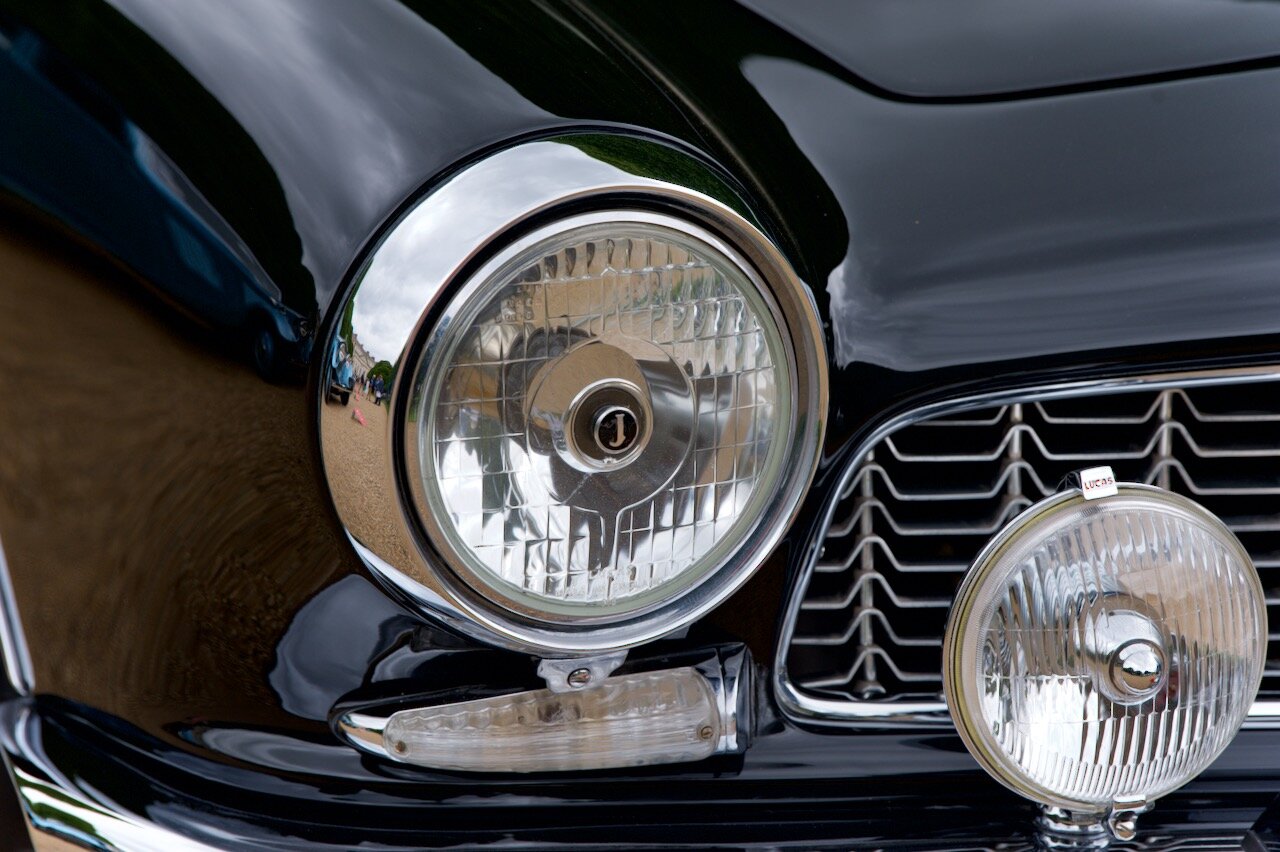


















Aston Martin DB5 crosses the finish line at Goodwood
Aston Martin DB4 4.0 litre - Goodwood Motor Circuit
The DB4 was launched in 1958 but in its original version was not perfect, as a consequence of which the car evolved through several different ‘versions’, the fifth of which in 1963 was designated the DB5. The DB5 sported an enlarged 4.0 litre version of the original straight-six, twin cam engine that had been designed by Tadek Marek, combined with a five-speed ZF gearbox and triple SU carburettors. In its standard form the revised engine pushes out just over 280 bhp. The original strong steel chassis of the DB4 carried over, covered with Italian styling studio Touring’s lovely aluminium “superleggera” (‘super light’) body on top. The DB5 also sports the enclosed headlights that were first seen on the DB4 Vantage and stopping power is provided by all round disc brakes. A huge boost to the car’s fame and popularity was its appearance in the hands of the ultimate British gentleman and fictional spy James Bond in the movie Goldfinger. His car carried a series of extras not available to buyers of the car, such as hidden machine guns, bullet proof shielding, oil spray from the rear and sophisticated (for 1964) tracking equipment. DB5s and other Aston Martins have appeared in other Bond films and this probably contributed to it achieving sales of just over 1,000 units, though it is a great looking and iconic car in its own right. Many of the original cars survive, but they are still highly collectible and have increased considerably in value over the years, though are unlikely to achieve the auction price of around £2.5 million of one of the original Bond cars.
Brabham BT3 Climax at Goodwood Revival 2013
Jack Brabham's first F1 Grand Prix car - 1962 Brabham BT3 Climax
1962 Brabham BT3 Climax (chassis number F1-1-62) - Apart from the lovely original turquoise blue and gold livery of this unique car, it has its place in history as the first Brabham team F1 car. Jack Brabham was still driving for Cooper when he started Motor Racing Developments (MRD) with his Australian friend, Ron Tauranac in 1961. The original purpose was to build Formula Junior and other race cars for sale to private teams, but Brabham decided that following a poor season driving with Cooper he would leave and develop his own F1 car to drive. The BT3 (where ‘B’ stood for Brabham and ’T’ for Tauranac) was a very conventional design for the period, with a tubular steel spaceframe chassis covered by a fibreglass body, rather than a ‘monocoque’ as launched on the Lotus 25 in the same year. It was powered by a 1.5 litre Coventry Climax FWMV V8 engine paired up with a Colotti Francis six-speed gearbox as previously used by Brabham at Cooper. This gave the 485 kg car just under 190bhp at 8,500 rpm. MRD were challenged to get the car fully prepared for the 1962 season and it only debuted in August at the Nürburgring for the German GP. Disappointingly Jack Brabham only qualified the car in 24th place and in the race he had to retire with a broken throttle cable. In this early development phase, the team also ran with a Lotus 24, so the BT3 did not race in every GP. In 1962 it raced in two further F1 races, placing fourth at both Watkins Glen and Kyalami, though it also qualified in 3rd position in South Africa. The car was effectively a prototype for the BT7 which was to run in 1963 and which in 1964, driven by Dan Gurney, gave Brabham their first Grand Prix victory. Whilst the BT only ever competed in six World Championship races, it did give Jack Brabham victory in some non-championship races, such as the 1963 Solitude Grand Prix and the 1963 Austrian GrandPrix. The car was therefore the first F1 car to be driven bearing the same name as its driver and the first to score championship points on the same basis. With only a little development it also formed the basis of the BT4, a successful Tasman Series and Intercontinental Formula car. At the end of the 1963 season the BT3 was sold to a privateer, Ian Raby, who replaced the Climax engine with a BRM V8 and he raced the car a few more times in 1964 and 1965. In 1965 he sold the car to David Hepworth, a hill climb champion, who used the car in hills climbs fitted with a Chevy V8. Shortly after it was taken in to the Donnington Grand Prix museum collection where it stayed until 2012, having been restored to its original 1962 build specification. Since 2012 the car has been used again for historic racing. The blue and gold livery of the car is the original, but for cars following Brabham replaced the turquoise blue with a dark green, in line with Australia’s national colours. The car is photographed here at the Goodwood Revival in 2013.
One of winning trio at Le Mans in 1966 Ford GT40 MkII 7-litre (chassis no P/1016)
1966 Ford GT40 MkII 7-litre (chassis no P/1016)- Le Mans Classic is not happening this weekend and it’s Independence Day in the US so here’s one of the famous winning Ford GT40s from 1966. This car was the third of the trio that gave Ford its famous 1-2-3 first victory over Ferrari at Le Mans in ’66. However, in many ways it was the more important of the three cars in achieving the win, as it was the car that had put in the most pre-race development time to sort out the overall design and make the GT40 ready for the 1966 attempt. In the actual Le Mans race the car was driven by Ronnie Bucknam and Dick Hutcherson, an established NASCAR and dirt-track driver. In development the car was driven principally by Ken Miles and Ronnie Bucknam, who was key to Honda’s F1 programme too. The car was one of three delivered to Holman-Moody to run in 1966. Holman-Moody was one of three factory-approved teams for the GT40 programme, following the programme’s re-organisation for 1966, and had established its credibility running Ford’s highly successful NASCAR program. The car was originally painted in Ford’s traditional white colour, with a black hood. Whilst the chassis number of P/1016 was within the normal production sequence, it and the other 1966 GT40 race cars were modified to a MkII spec which included a stiffer chassis with thicker-gauge steel, strengthened engine mountings and advanced suspension using two-way adjustable Koni dampers. Endurance was also enhanced with a stronger driveshaft and Kelsey-Hayes ventilated disc brakes. The cars also now sported the 427 cubic inch ‘big-block’ V-8 that Ken Miles had immediately concluded should be used following his first test with it in 1965. Holman-Moody’s significant experience running the engine in NASCAR generally allowed them to set it up for 450 bhp, and that was combined with dry-sump lubrication and lighter aluminium heads and a magnesium oil pan to save weight. The MkII body was similar to the MkI, but both wider and taller to accommodate larger wheels and it also sported additional rear engine/brake cooling scoops and an adjustable spoiler. Chassis 1016’s racing debut was at the 1966 Daytona 24 Hour race, where it used an experimental two-speed auto-box, which failed in the race. Soon after it raced at Sebring sporting the Kandy Gold livery (without the pink highlights) for the first time, but only managed 12th and after that the auto-box was removed. By the time of Le Mans, the helmet bulge had been added to the roof/driver’s door of the car and the matte Day-Glo pink highlights had been added to its livery on the nose and sides of the car, as it wears today. The car started at number nine on the grid and reached 3rd place within a lap before gradually dropping down to 10th place suffering braking problems. After a major pit stop in the night several hours in to the race, it slowly closed its way back up the field, reaching 4th after 11 hours and 3rd again after 17 hours, where it remained through the final stages of the race. After Le Mans the car served a period of time touring US Ford dealerships as a promotional car, before in early 1967 being used as a ‘test mule’ by Holman-Moody for the latest variant of the GT40 the MKIIB. In February 1967 it was driven at Daytona again but this time by Mark Donohue, but without success. This was the last ‘in period’ race appearance by the car. It was used for further testing, including at Le Mans, where powered by the latest variants of the 7-litre engine giving out some 490bhp it recorded a speed of 203mph on the Mulsanne straight piloted again by Mark Donohue, which placed it as the fourth fastest lap time overall. After this the car was on display and passed through various owners with some vintage race appearances, before in the early-1990s being restored to more or less its 1966 Le Mans spec with the exception of a few Mk IIB upgrades (roll cage, aluminium instrument panel and automatic fire extinguishers). As a vintage racer the car has been driven by a number of famous Le Mans veterans such as Brian Redman and Jacky Ickx, amongst others, and has been a regular racer as well as being on display at numerous events globally for many years. There were eight GT40 MkII cars built, but with its gold and pink livery P/1016 is perhaps the most easily recognisable one of them apart from having a clear place in Le Mans and motorsport history. It is also an extremely valuable car having last sold at auction in 2018 for just under $10 million. The pictures here are from the car’s appearances at the Goodwood Festival of Speed in 2009 and at the Goodwood Revival in 2013.
1954 Jaguar XK120 special with coachwork by Pininfarina
This is another beautiful unique car based on the XK120 with coachwork by Pininfarina. The cars origins are well known, but not long after its creation the car was not seen for many years until a complete restoration four years ago. The original car was delivered in 1954 to Max Hoffman, a well known importer of European luxury cars to the US and based in New York. He was originally from Austria and was involved in the inspiration of a number of transformations of cars from mainstream car makers, such as the Mercedes 300SL “Gullwing” and BMW 507, so a well recognised automotive aficionado. He gave the XK120 to Pininfarina and his Italian coachwork design house with a brief to transform it into something more special. From the restoration it was seen that Pininfarina actually used the originally body of the car as a base to work from. The completed newly bodied car was shown for the first time at the Geneva Motor Show in April 1955 and later that year at the Autocar Show. After that Hoffman took delivery of the remodelled car. It was after this the car disappeared from view until it was acquired by a German in 1978, who had the intention of restoring it but never completed it. The project was resurrected in 2015 when the car was bought by noted UK classic car specialists Classic Motor Cars or CMC. CMC spent some 6,700 hours on the restoration of the car from the bottom up. The original external and interior colours were not known at the start of the project, as at some point the car had been sprayed Burgundy and the interior re-clad in tan leather. The exterior colour only came to light when an original patch was found when the windscreen was removed. Similarly a small strip of the original leather in the interior was found when stripping out the existing upholstery. Whilst much of the car is original, some reconstruction of parts was required, such as the chrome bumpers, lights and some of the glasswork, as well as quite a few panels of the bodywork. The mechanics of the car include a standard XK120 3.4 litre straight-six engine with twin SU carbs and giving a power of some 180bhp. Since restoration the car was unveiled at Pebble Beach in 2017 and has also since been shown at Villa D’Este and Hampton Court and here is pictured at the 2018 Goodwood Festival of Speed Cartier Style et Luxe concours. It is a truly stunning restoration of a beautiful and unique Jaguar.
1962 Jaguar E-type Fixed Head Coupé
1962 Jaguar E-type FHC (chassis no 860545) - This car has been a competition car all its life, originally driven by Malcolm Fruitnight for the Merlyn Formula Junior works team. He won a couple of races with the car in 1963 at Snetterton, which was a noted performance given this is one of the steel-bodied versions of the car and not a lighter weight example. The car competed in period at Goodwood at events such as the 59th Members Meeting and at very recent events there, including the Kinrara Trophy at the Revival. It also raced in the Jaguar Heritage E-type Challenge. The car is painted opalescent blue, the same as its original colour, and is registered for road use under its original licence plate 170 FPX. With its wire wheels and GB sticker, presumably from past forays to race or tour in mainland Europe it’s a true “Gentleman racer’s” car. The pictures here are from it testing at Goodwood for this year’s 78th Member’s Meeting, which sadly has not happened.
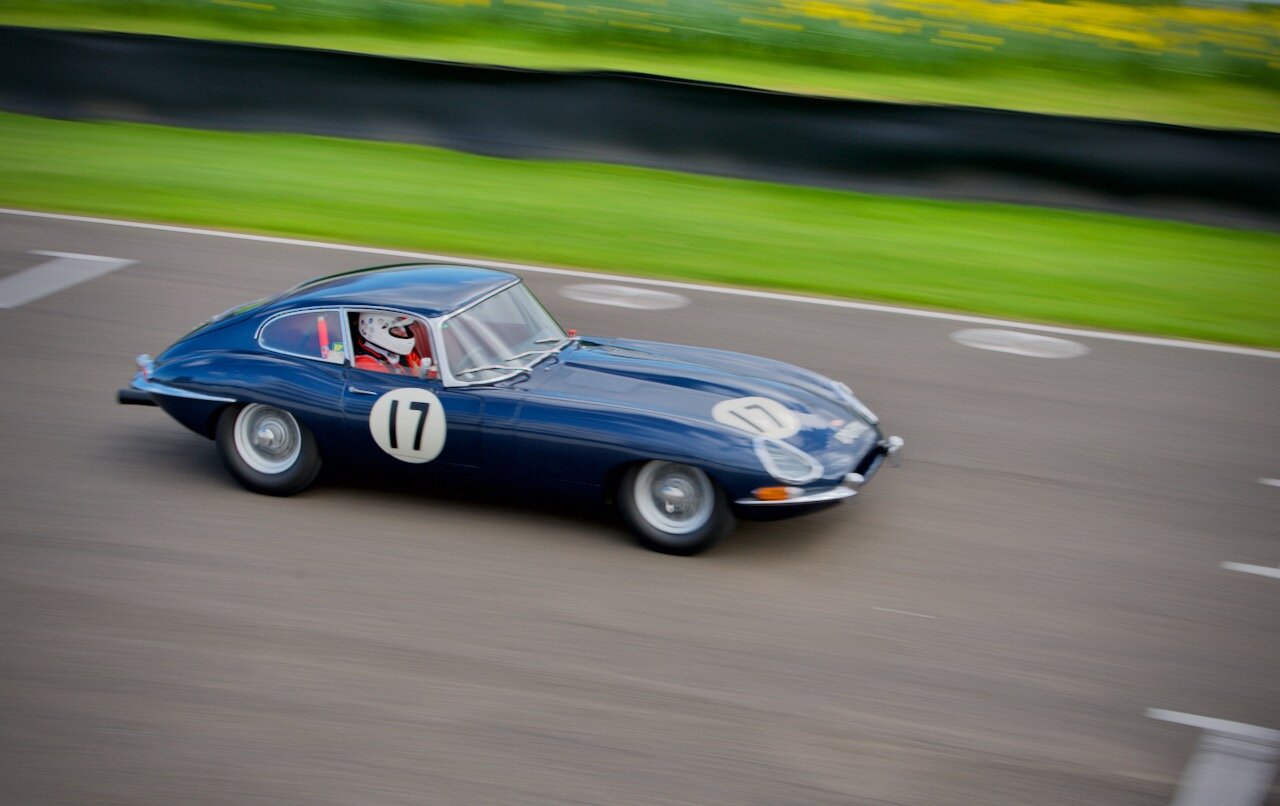


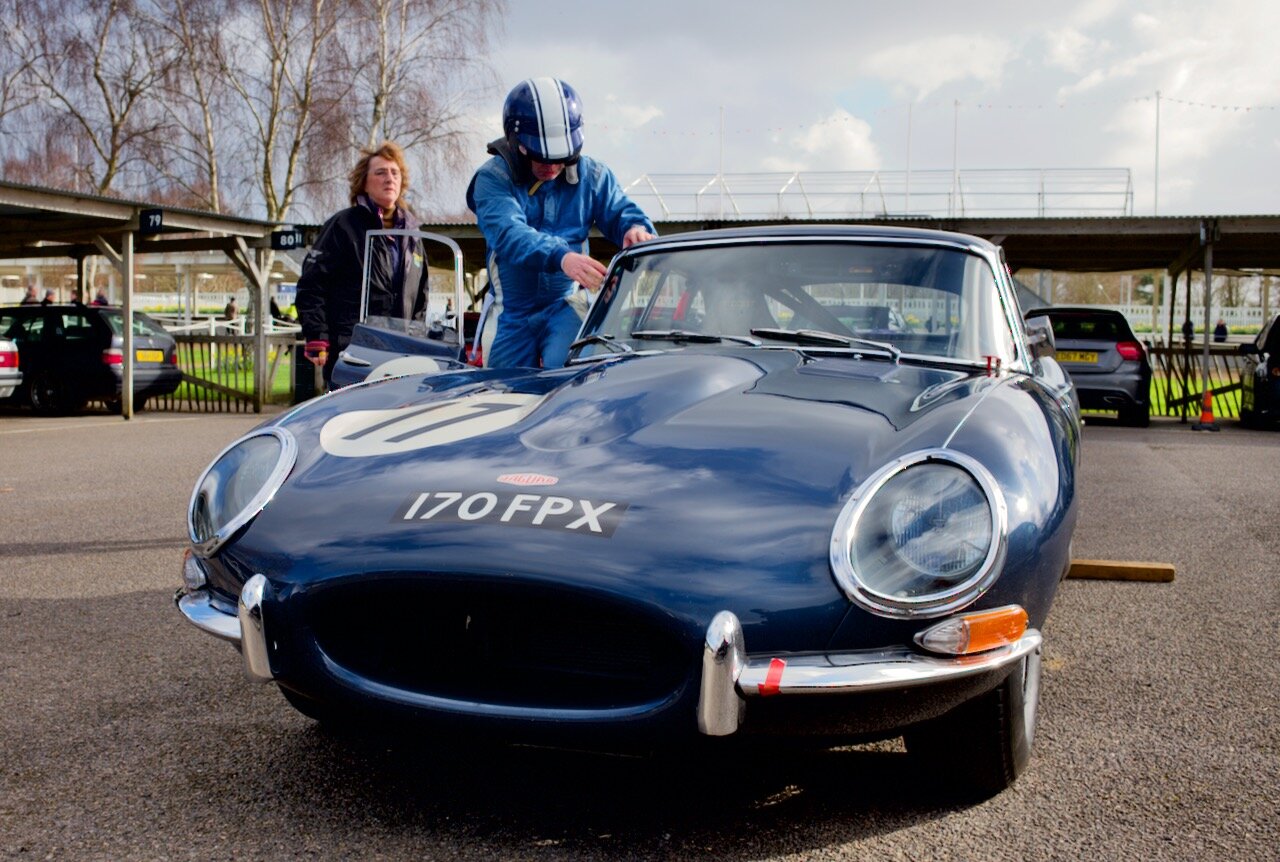
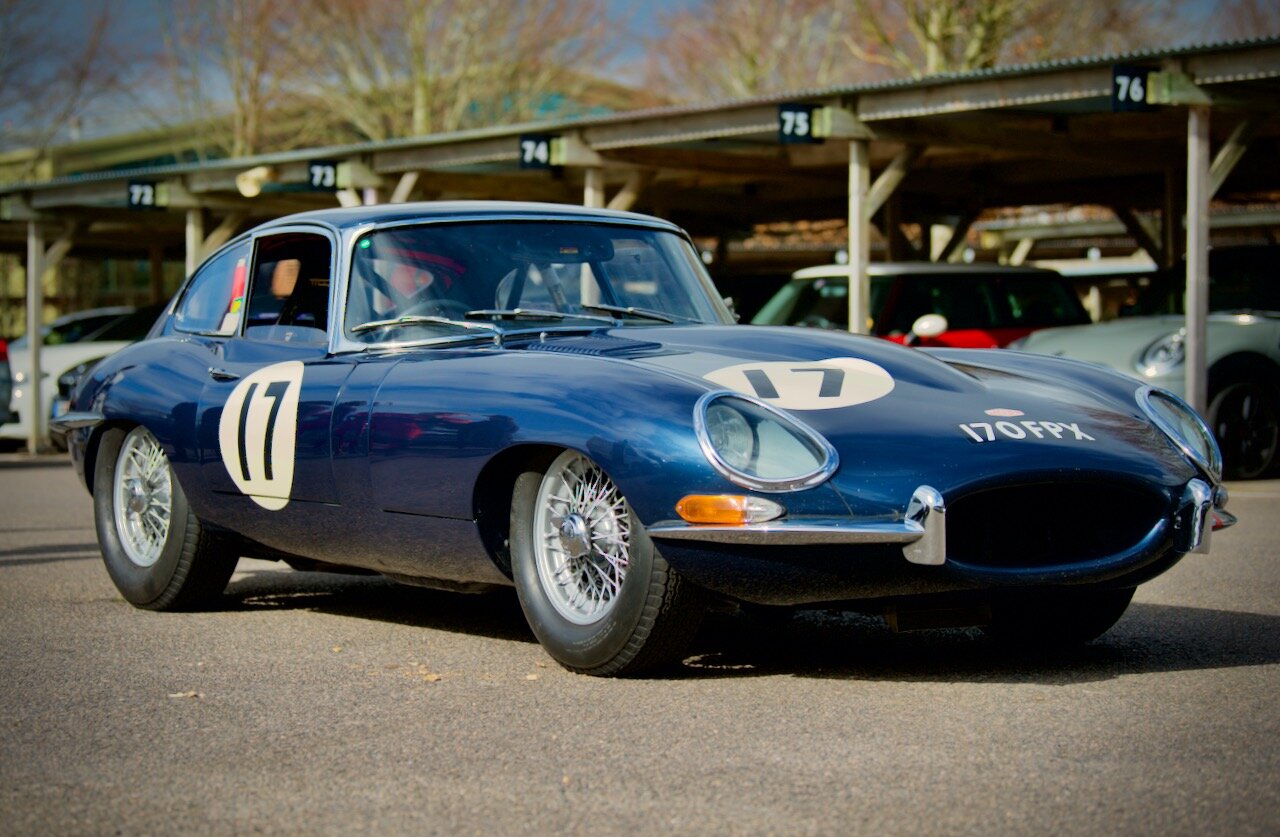
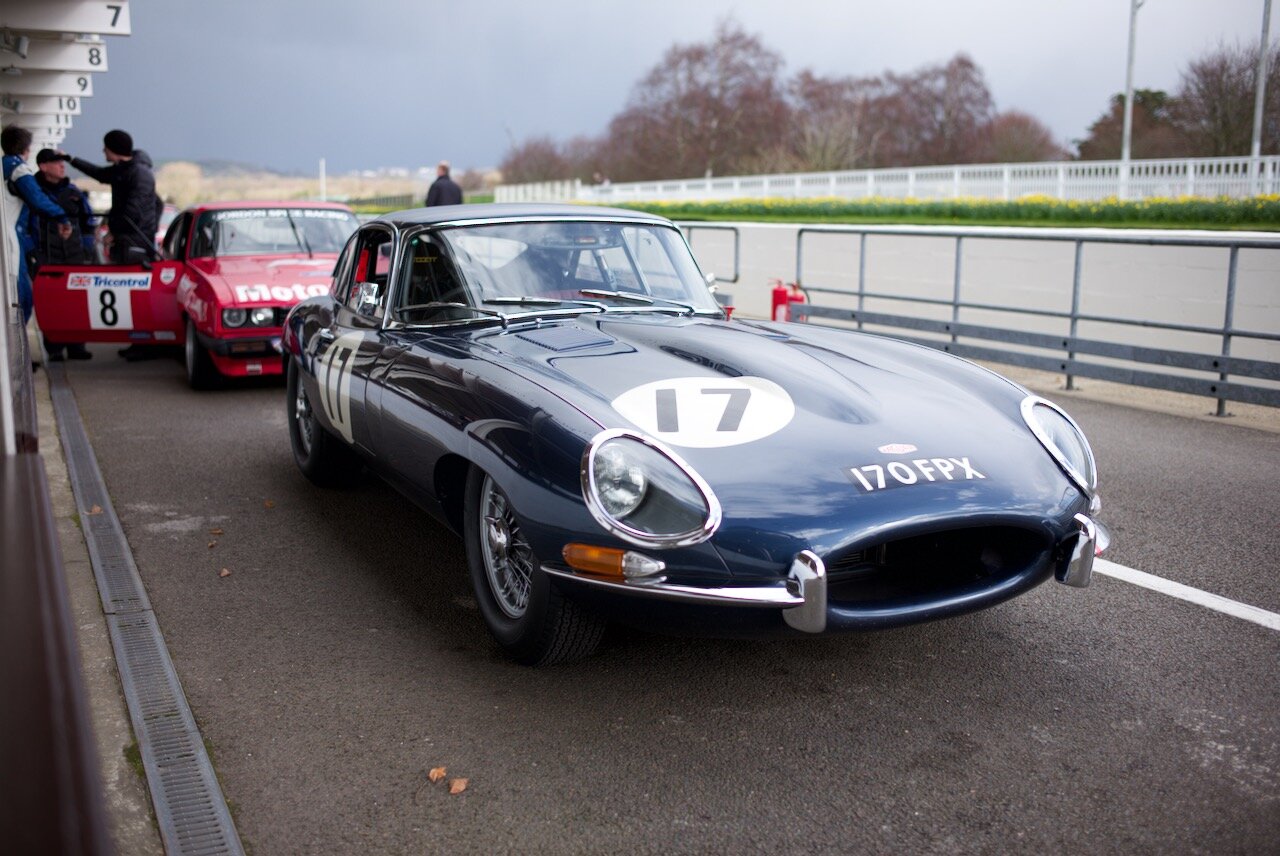
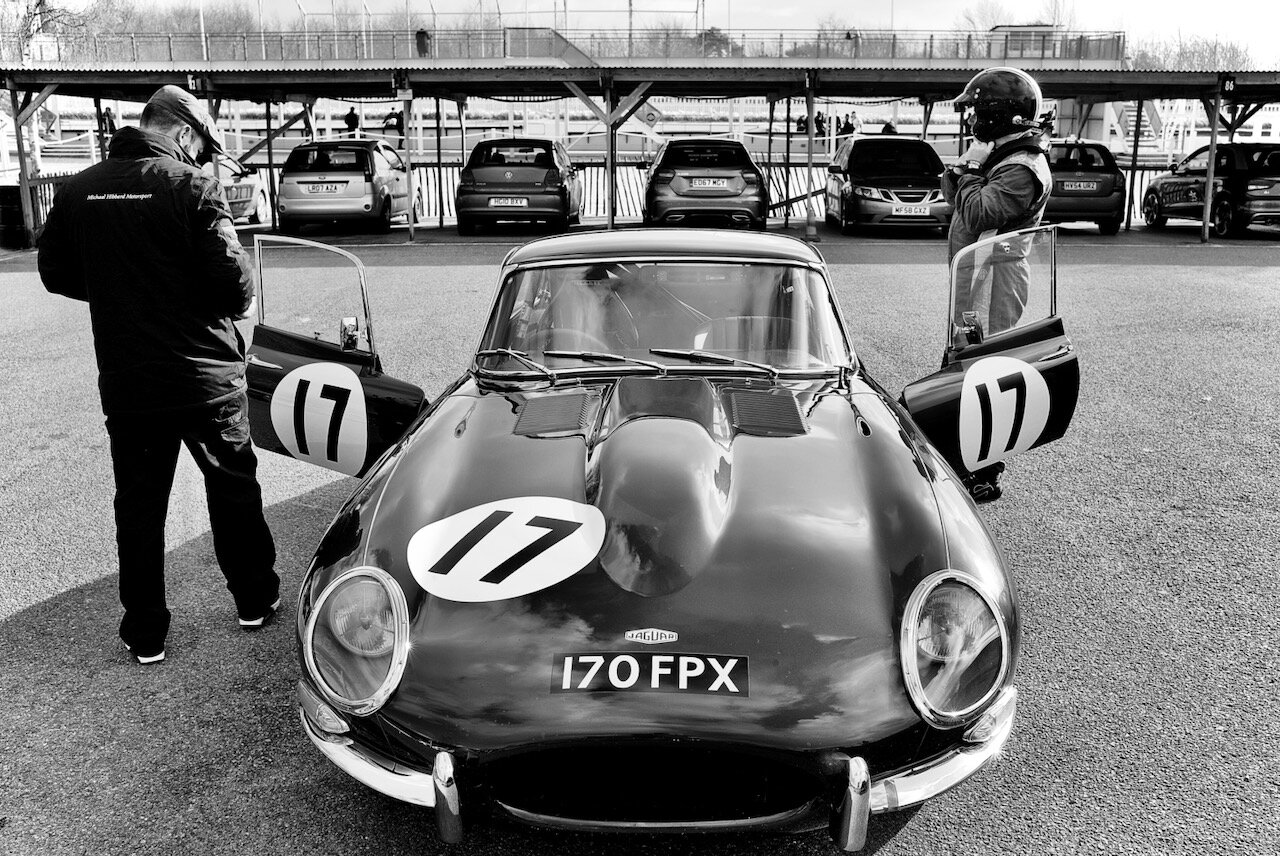
DB4GT Zagato at the Goodwood Revival in 2011
1960 Aston Martin DB4GT Zagato - One of the most desirable cars
Aston Martin finally won at Le Mans in 1959 with the DBR1, after a number of years trying and at considerable cost. In the second half of the 1950s the popularity of 2-door Grand Touring or GT cars was increasing considerably and this was extending into racing as well. A GT class was also introduced in the Le Mans 24 Hours from 1959. Aston Martin had launched the DB4 in 1958, drawing heavily on its racing expertise such that the car sported disc brakes and independent front suspension and were also available with a lightweight (“superleggera”) body. This all made it logical for Aston to reduce its commitment to the costly racing programme that had spawned the DBR1 and instead focus on the new GT class, continuing its exposure to racing but with a more commercial focus. The GT version of the DB4 was launched in 1959 with a stripped out interior to save weight, a shorter wheelbase and a lighter body, plus a scooped bonnet covering a new more powerful 3.6 litre engine increasing power to just over 300bhp. Unfortunately, Ferrari had just launched a new short wheel base version of the 250GT which had a smaller engine but was much lighter and more agile than the Astons, so frequently beating them. To try and counter this and improve the performance of the DB4GT, Aston Martin turned to the Milan based coach builder, Zagato, who had demonstrable experience with Alfa Romeo and Lancia in slimming down their race cars. Ercole Spada, a new young talent at Zagato, was given responsibility for the the project and produced a body shape which is acknowledged for its clean attractiveness. Unfortunately, he had less success in reducing the weight of the car and in an attempt to compensate the engine was developed to give a higher power output of some 314bhp. As Aston advanced its designs, inevitably so did Ferrari with their 250 GTs by then putting out 285 bhp in cars that were still 25% lighter than the Zagato Aston Martins. Jaguar had also introduced its new lightweight version of the E-type, which scored a victory in its maiden race. The net result of all this was whilst the Zagatos and ‘standard’ DB4GTs are beautiful and highly desirable for collectors today, they only ever scored a limited number of wins and in racing terms were less successful than their reputation would suggest. In the three years of production, Aston Martin made just less than 100 DB4GTs, of which 19 were equipped with Zagato bodies and of those four were road going rather than race versions. None of the original Zagatos are exactly identical. Two of the most famous original racing Zagatos are known from their registration numbers as “1 VEV” and “2 VEV”, the first of which is pictured here. Both cars raced in John Ogier's Essex Racing Stable team with factory support from Aston Martin and both competed in the 1961 24 Hours of Le Mans. Unfortunately neither car finished (1 VEV due to head gasket failure), but in July 1961 2 VEV beat a Jaguar E-type on the last lap to take the British Grand Prix GT support race. 1 VEV’s greatest moment was in the hands of Roy Salvadori at Goodwood in the 1961 Tourist Trophy, when it was pipped for second place by a Ferrari 250GT driven by Mike Parke. The car was hard on tires and in the 420km race went through 14 new ones. In 2007, the car was completely restored. It sold at auction for £1.54 million in 1990, but 2 VEV sold for over £10 million in 2018, illustrating the desirability of these cars today.

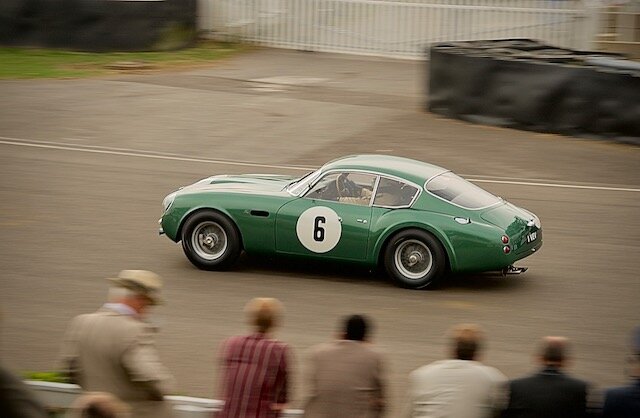
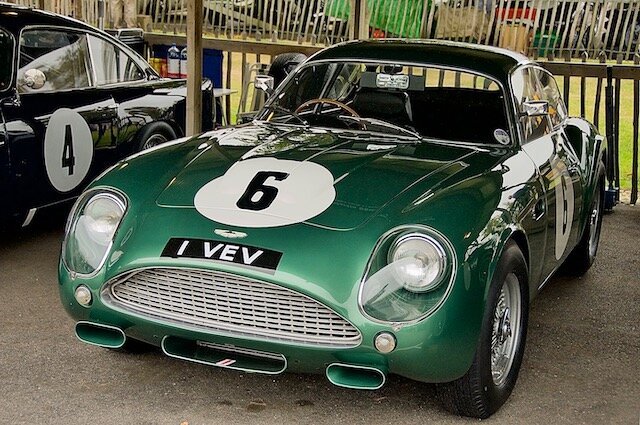

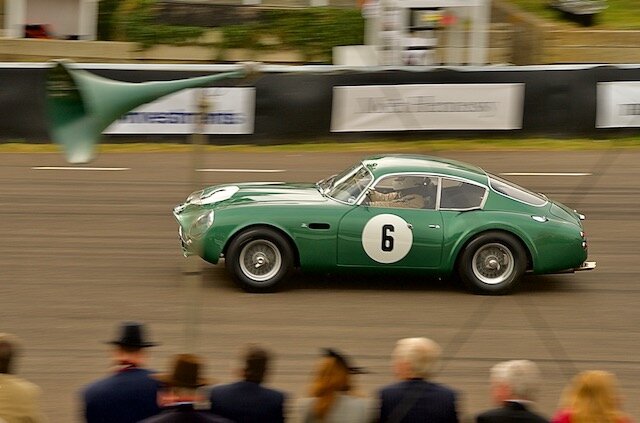
1929 Napier Bentley
This is a spectacular car to see racing on the track. Unfortunately it is not wholly original, as it was only built as a one off special in 1968 using a Sunbeam Tigress chassis; then following significant damage in a major accident in 1972 it was re-built on a 1929 Bentley 8 chassis to result in the car you see here. The engine is a huge 24-litre beast, a Napier Sea Lion aero-engine. It powers the two tonne car with 580bhp with 1,250lb ft f torque. This results in a fire-breathing dragon of a car that pops and bangs and regularly spits out flames, easily spinning its wheels from a standing start. Reputedly under the bonnet it carries a warning notice: “The ultimate laxative”! Thanks for creating this car go to Peter Morley and David Llewellyn, though Peter, together with his son Clive, was the one who principally drove it over the first 25 years of its life. The Morley family continue to race Bentleys, though no longer own this magical beast. The car has been raced regularly at historic events with great success and here is pictured at the Goodwood Revival in 2007, blowing out smoke and flames in its usual style.
1971 Porsche 917 LH chassis no 917-045
Hans Mezger (RIP) and the story of the Porsche 917
The Porsche 917 was designed under the leadership of legendary Porsche engineer Hans Mezger who recently died at the age of 90 (RIP). Whilst he was involved in many aspects of the Porsche race and production car programme over more than 35 years, the 917 is perhaps his most iconic achievement. Like a number of manufacturers in the 1950s and 60s Porsche had ambitions to win at Le Mans. By the mid-60s Ford and Ferrari were dominating in the battle to win there with hugely advanced, powerful cars that Porsche found it difficult to match. Their cars were nimble and handled well, but under-powered at Le Mans with the importance of outright speed on the long Mulsanne straight. Rule changes in the late 1960s, which reduced the required number of cars to be homologated to 25, finally gave Porsche the chance to compete. The target class was Group 4 for 5-litre sports cars, which would require a significant new engine design of a size in which Porsche had not previously had experience. The aim was to design and build the car within a very short 10 month time frame, ready for the 1969 race. The structure of the car was to be based on the 908 but using more advanced materials and construction. Reputedly the Porsche Motorsport Team totally miscalculated the time needed to complete the 25 required homologation examples. They fooled the inspectors by fitting some with wooden brake calipers, some hastily glued-on parts and some even had fake engines. Fortunately none of the inspectors took up Ferdinand Piëch’s offer to test drive the cars. The engine design was a massive 5-litre flat V12, which was air-cooled in line with Volkswagen’s conditions for providing a substantial portion of the cars funding. Cooling was achieved using a huge fan to suck air down in to the engine. The first cars were what became known as ‘Langheck’ or ‘Long-tail’ versions and terrified their factory drivers with their high speed handling, some regarding them as “rolling coffins”. David Piper was one of the drivers who played a key role in the development of the Porsche 917, driving it at its debut at the Nürburgring 1,000km in 1969 and to its first international victory with Dickie Attwood at the Kyalami 9 Hour race. In an interview about his early experience with the car, he is quoted as saying: “The 917 was a dreadful thing when I first drove it, virtually undriveable. Porsche asked me to race it at the Nurburgring. None of their test drivers were prepared to give it a go, and they asked me if I knew anyone else who would share with me. So I got hold of Frank Gardner; he said he was up for it, so off we went to Germany. Early on the first morning it was foggy and wet and there was this white car neither of us had seen before, the first Porsche 917. So I hopped in and set off into the Nordschleife. Unfortunately I didn’t put my ear plugs in and the noise from that air-cooled flat-12 was excruciating, because two of the exhaust pipes came out underneath the doors. It had tremendous power but it was difficult to keep it on the road – it was wandering all over the place like a Volkswagen – and the brakes weren’t very good either, plus you were virtually lying flat on your back with your chin on your chest. It squatted down on its back wheels and it went from negative to positive camber the faster you went, so once you started going quickly it was undriveable. I told Frank to be very careful and he came in after one lap and said ‘Jesus, if we go off round here they’ll need a compass to find us!’”. Piper went on to say that “it was a very good car once it was sorted out.” The 1969 24 Heures du Mans is probably a race Porsche would rather forget. None of the works drivers would yet drive the car given their early experience and one of the three cars entered crashed, killing its British driver. The other two 917s entered did lead the race for short periods, but both retired before the full distance of the race. Porsche continued to develop the car to improve its handing, but did not enter a works team at Le Mans in 1970, leaving it to private entrants. One of the principal changes made to the car was the development of the K (for ‘Kurzheck’ or ‘Short-tail’) version, which radically improved its handling. The private teams running in the 1970 race included both LH and K versions and finally the 917K driven by Hans Hermann and ‘Dickie’ Attwood claimed victory for a Porsche, beating the LH version run by the Martini team. Many of the original LH versions were converted in to Ks and a number of totally new K versions were also built, but the LH version was also developed further to improve its stability and handling. So by the time of the 1971 race at Le Mans there were again a mix of new LH and K versions entered. The most advanced of the cars on the grid was a K version built on a magnesium structure and entered by the Martini team. Whilst it turned out to be a bit slower than the latest ‘Long-tail’ cars racing in the JWA Gulf livery, both the LH versions retired leaving the field clear for the Martini car to win. After the 1971 victory the 917s were made redundant for Group 4 racing by rule changes, but rather than abandon them totally, Porsche looked to develop the car further for CanAm racing. They had already started their involvement in CanAm with the 917/10. This again proved highly successful. Initially it became clear that to be competitive much more power was required for the Porsches and so turbo-charging became the favoured solution. Putting out some 950bhp the 1972 turbo-charged cars won the CanAm championship beating the previously dominant McLarens. One last version of the car, the 917/30, was developed with power increased to some 1,100bhp from a 5.4 litre engine sitting in a longer and more aerodynamic body shape to significantly increase top speed. This car driven by Mark Donohue won the 1973 CanAm championship and perhaps best reflects the nickname “Turbo Panzer” that has become synonymous with the 917. In a specially set up run in 1975 the 917/30 set an average speed of 221mph around the Talladega race circuit.
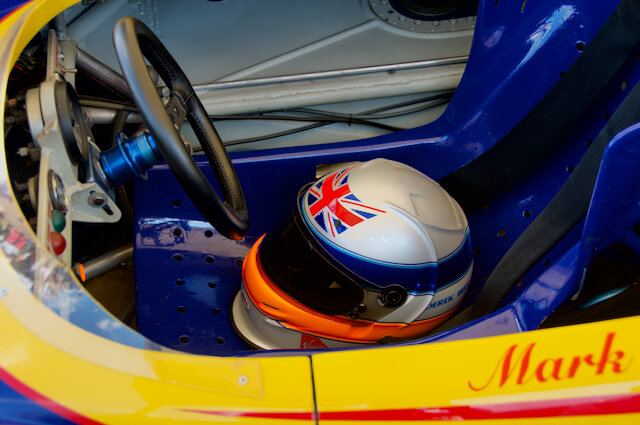
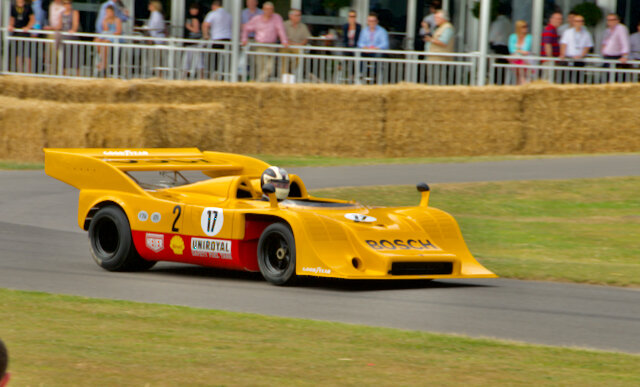

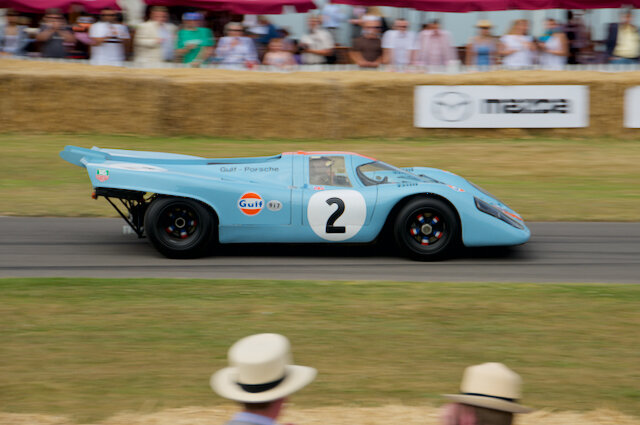
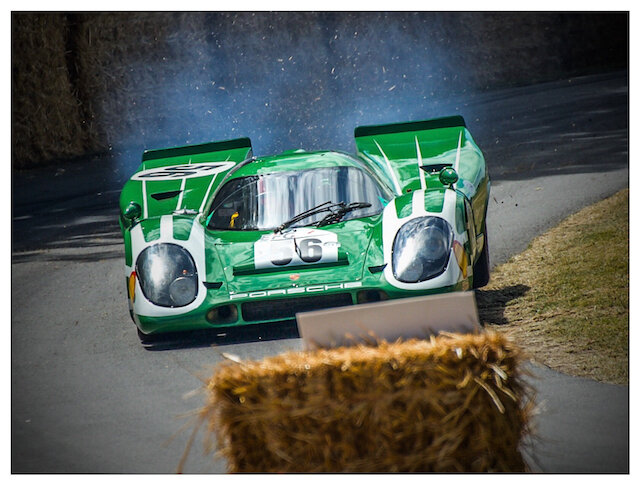
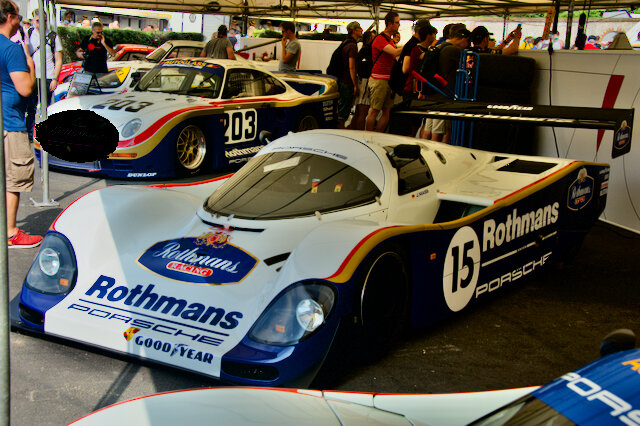
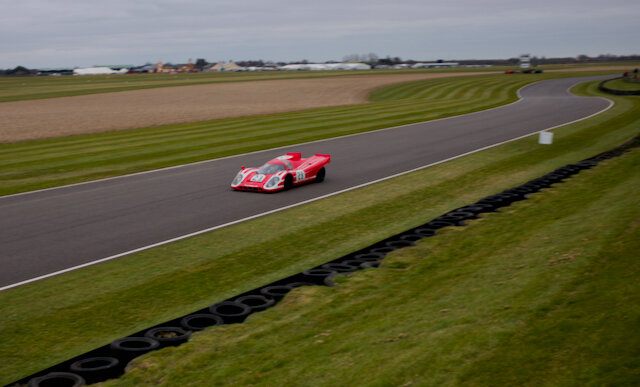
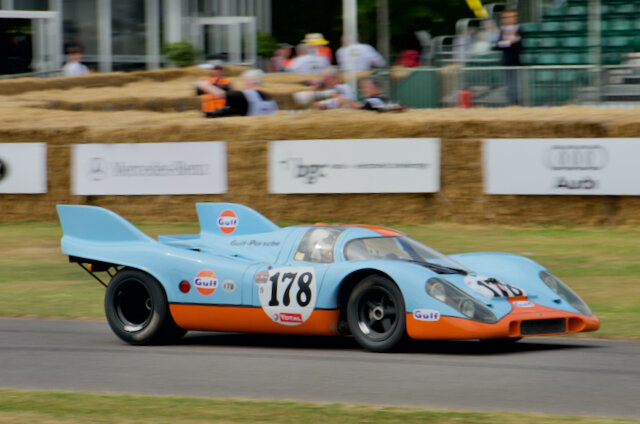
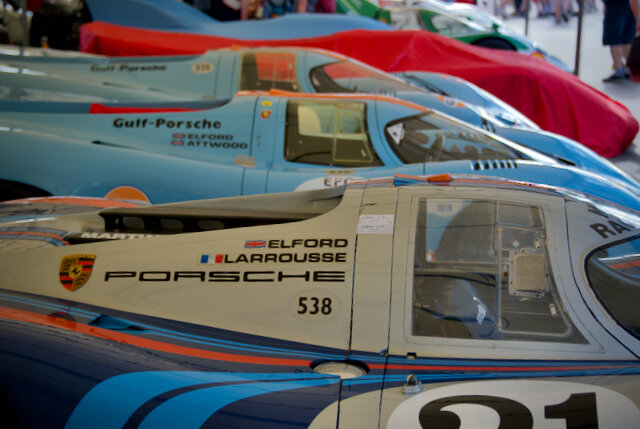
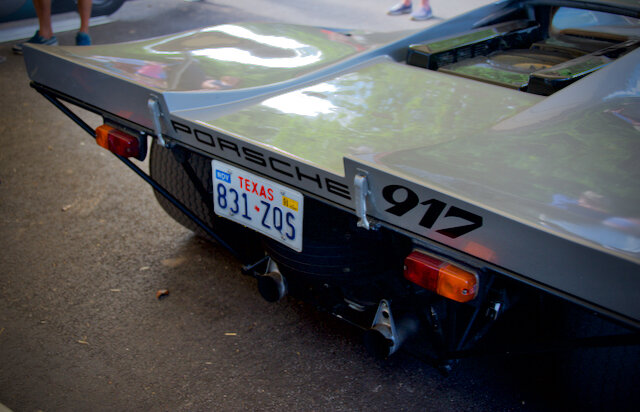
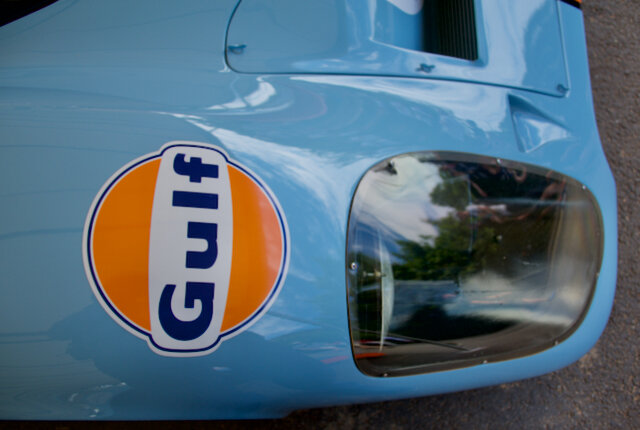
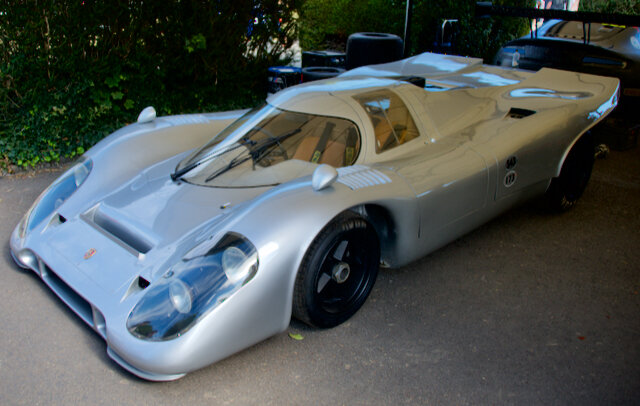
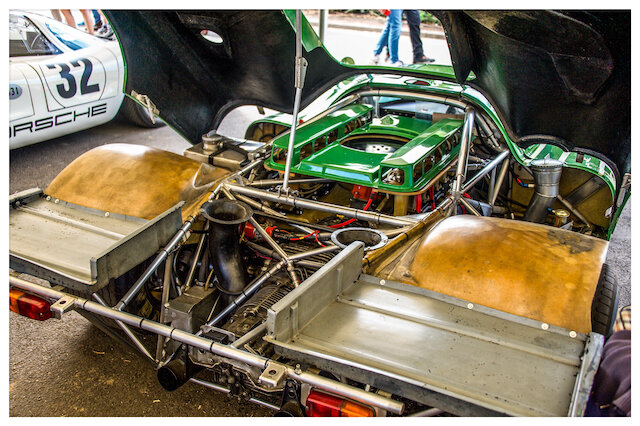
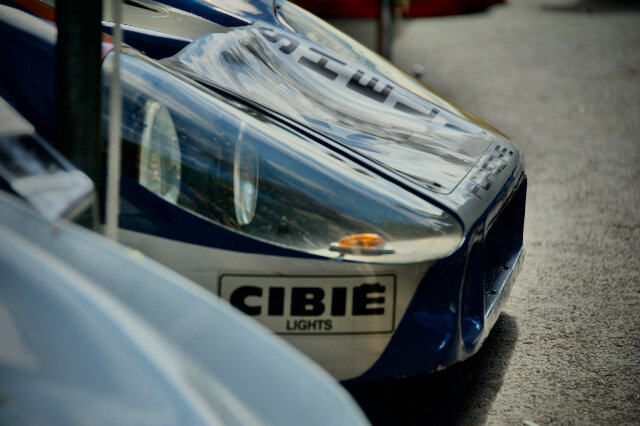
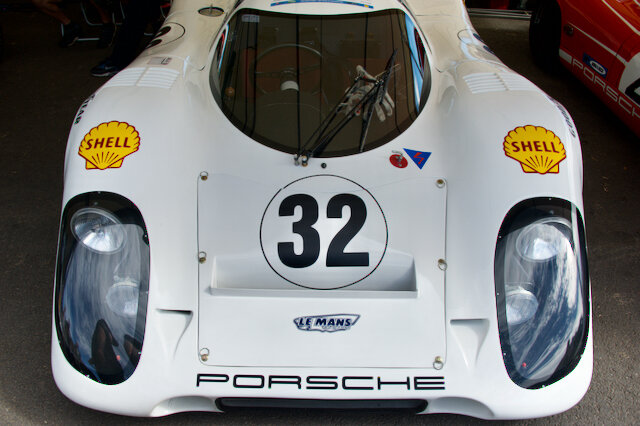
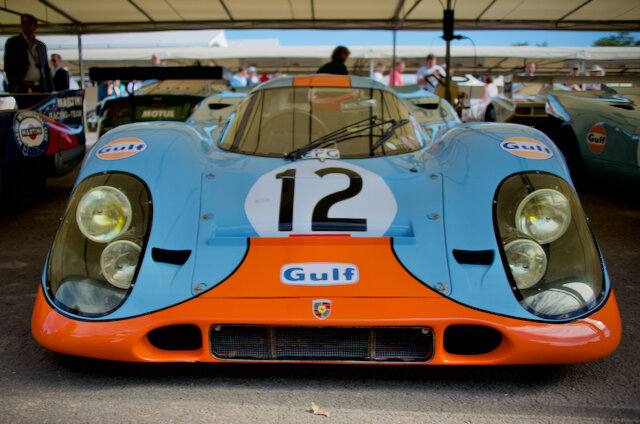
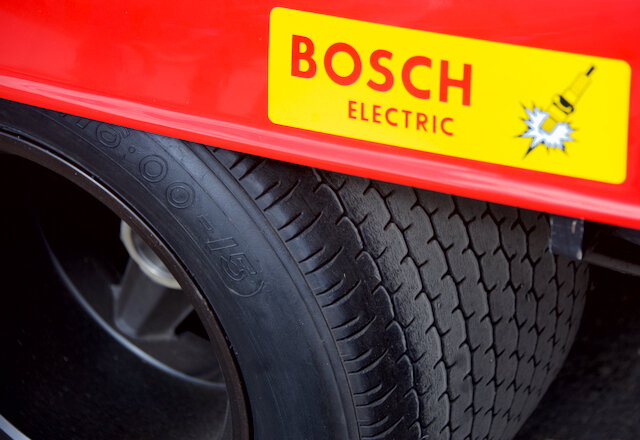
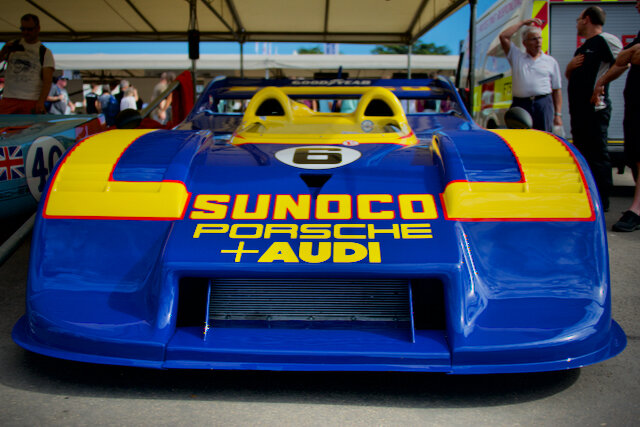

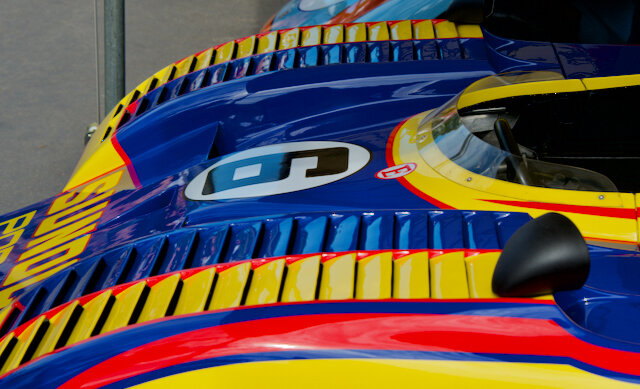


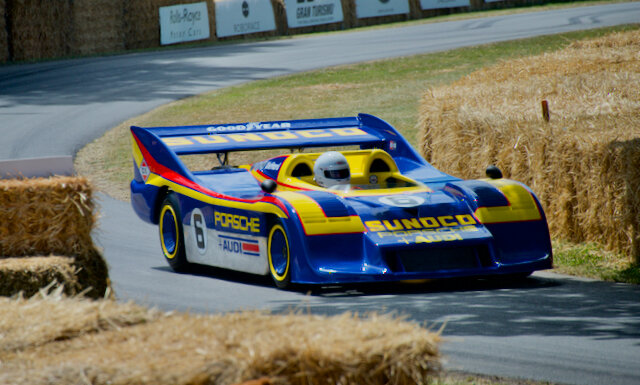
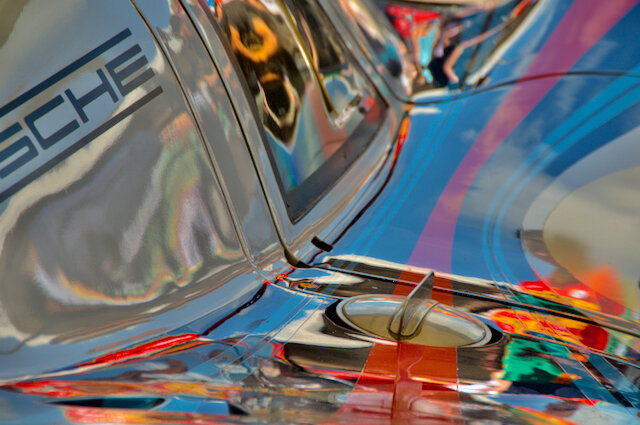
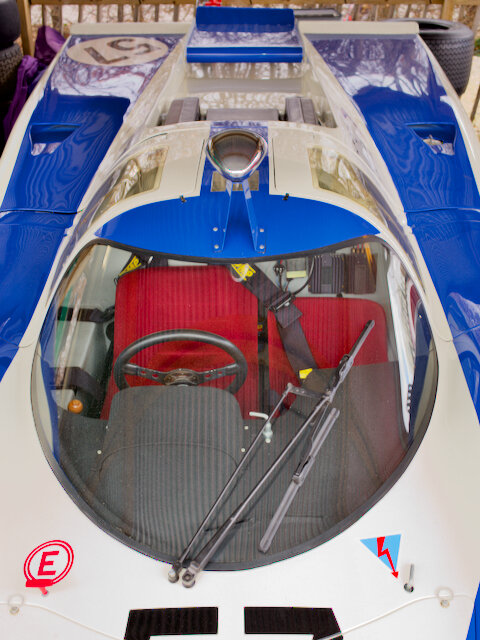
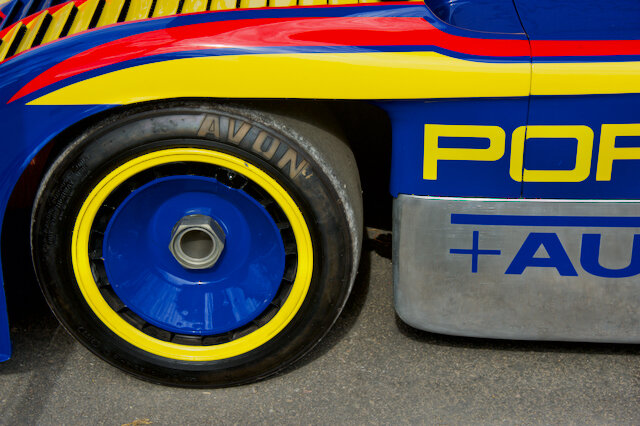
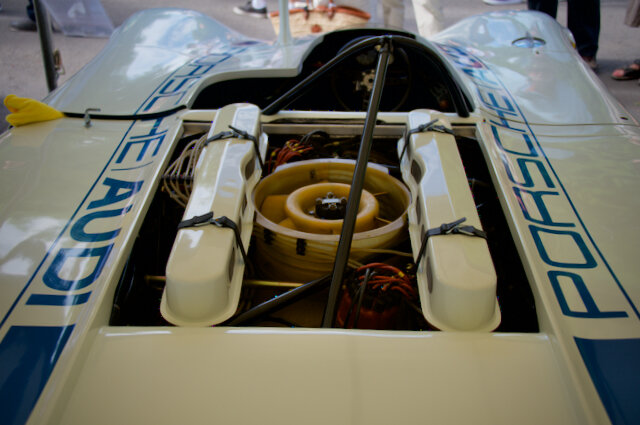
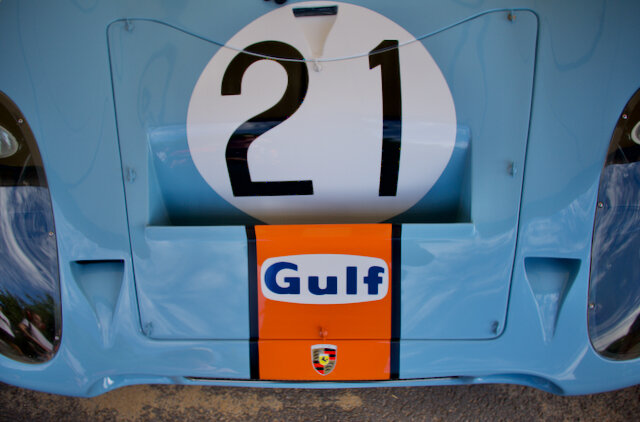
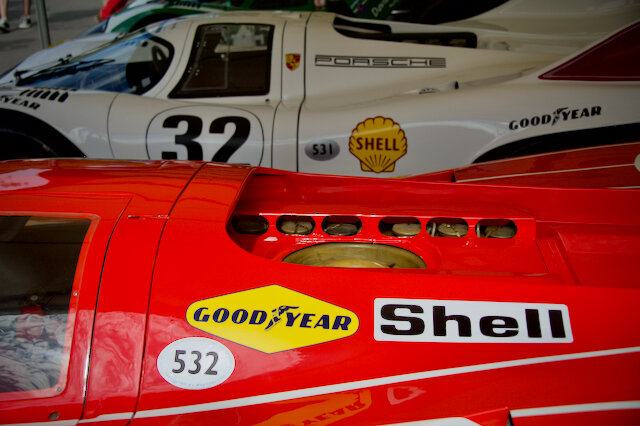
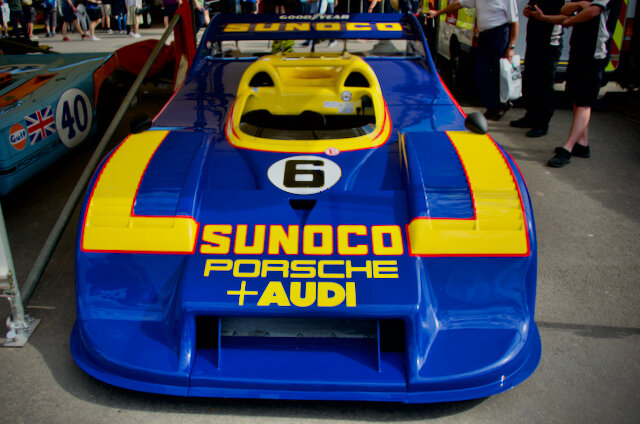
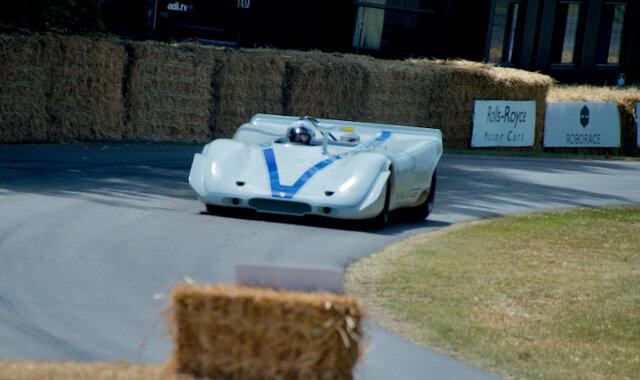
Bentley Speed 8 Le Mans winner 2003 at Goodwood Festival of Speed
2003 Bentley Speed 8 winner at 2003 Le Mans 24 Hours race
2003 Bentley Speed 8 - ‘Bentley’ as a marque is synonymous with the 24 Heures du Mans having dominated the race in the 1920s with five wins, before its acquisition by Rolls-Royce and the absence of a works racing presence for the next 70 years. In 1998 the marque was purchased by Volkswagen Audi Group and, with a view to reinvigorating its image, in 2000 Bentley announced a three year programme to win again at Le Mans. Audi already had a strong presence in sports car racing which would help and complicate Bentley’s attempt, though Audi’s immediate success was in a different class to the LMGTP class Bentley was targeted. The car was to be designed in the UK by Racing Technology Norfolk (RTN), who had been involved with Audi’s race programme, but contrary to rumour both the initial prototype and final cars were not “re-skinned” Audi’s but totally new designs. They did share the Audi’s twin-turbo 4-litre V8 engine, giving the car a theoretical 615bhp to power just under 1,000kg of weight. Peter Elleray was the lead designer of the cars. Bentleys raced at both the 2001 and 2002 Le Mans with top 4 placings and wins in class, but overall success eluded them. The 2003 car pictured here was effectively a totally new car and this is evident when one looks at it in detail. Many modern race cars designed purely for racing inevitably end up very functional looking at the expense of pure beauty - the Speed 8 is an exception to this. The key to winning at Le Mans is a design which captures the combination of sufficient downforce for cornering with a very high top speed for the long Mulsanne straight; 215mph in the Bentley’s case. Downforce comes from the wing starting at the very front line of the car, but this then flows back into the bubbled cockpit of what is effectively an enclosed ‘open wheel’ racer, with air flow channelled down the sides. The rear then flattens down in to a highly aerodynamic, low upturned tail over the engine, but with a gigantic rear wing and diffuser, like the front giving the required downforce to keep the car on the track. For 2003 Derek Bell, who had been with the project from the start, oversaw Bentley’s third attempt with the Speed 8. The 2003 car was finally a winner, taking first and second both overall and in class, with the No.7 car leading the No.8 three laps ahead of the next finisher. Apart from Elleray’s design of the car, the 2003 success was helped by Audi concentrating its resources that year on Bentley’s bid to win, including the addition of drivers Rinaldo Capello and Tom Kristensen to the team. They were joined in the winning car by the British driver Guy Smith who in an interview with Motorsport magazine said of the car “From the very first test it was obvious to me that the Speed 8 was a different animal – it felt like a car you could jump in and drive to the shops. It was so easy to drive, the engine now so smooth and progressive. Once we got out on the track it was instantly quick, easily faster than the 2001 car, and more importantly it was consistent and reliable.” Sadly Bentley immediately stopped racing the Speed 8 after its win at the 2003 Le Mans, so the car never developed the race record it might have had otherwise. For fans, the cars still appear at motorsports events periodically, still sporting the battle scars of their 2003 victory and they are certainly worth seeing and hearing ‘in the flesh’. The winning cars are pictured here at the Goodwood Festival of Speed and Members Meetings over various years.
Goodwood Members Meeting postponed
Sadly the 78th Goodwood Members Meeting has been delayed for an indefinite period and the Festival of Speed scheduled for July already has also been postponed. Hopefully the Revival will still happen in September, otherwise there will be few photo opportunities for classic car events this year. I did get the opportunity to visit the Goodwood Motor Circuit on one of the practice days for 78MM before it was cancelled. There were some lovely cars on the circuit, including Ben Eastick’s lovely D-type Jaguar, pictured here in the pits.
Ben Eastick’s 1955 Jaguar D-type ‘Long nose’ Goodwood 78MM testing
Goodwood 78th Members Meeting 28th and 29th March 2020
Looking forward to the Goodwood Road & Racing 78th Members’ Meeting coming at the end of the month and fingers crossed that it will not be impacted by the Coronavirus pandemic. This year’s event promises to be as spectacular as ever, with the introduction of a rally sprint stage which will see Group 4, Group B, Group A and WRC-spec rally cars racing in the early evening. Other highlights are likely to include the battle of the Edwardian Leviathans in the SF Edge Trophy over 5 laps and demonstrations by both classic Lotus F1 cars and the TWR Jaguar Le Mans cars, 20 years after their victory there. As ever the event provides tremendous scope for all sorts of photographic opportunities, the results of which I look forward to sharing with you afterwards. Visit this site again in April/May or follow for more regular updates @superchargedclassics on Instagram and Facebook (click icon link on page).
1983 Lancia Rallye 037 Goodwood Festival of Speed 2018

